Microsoft RM-236 GSM Cellular Phone with BT User Manual Manual 2
Microsoft Mobile Oy GSM Cellular Phone with BT Manual 2
Contents
- 1. Manual 1
- 2. Manual 2
Manual 2

Write text
The input methods provided in the device may vary
according to different sales markets.
Input method indicators
The input method indicator is shown in the
navigating field or on the upper right corner of the
inputting frame. Please note that not all input
methods are available under all circumstances.
Press * to view other available input methods.
Default input method
Please notice that aiming for different
requirements for various characters' input
positions, the device has preset the relevant default
input methods and usable input methods. For the
input positions where the default input method is
Pinyin, you could change into other input method
as default when necessary.
Press , and select Tools > Settings >
General > Personalisation > Language >
Default input. This selection is only visible when
you select a Chinese language in the writing
language setting.
Switch input methods
Press * to select desired input method from the
selection list (the currently the active input method
is not listed).
Press # repeatedly to switch among different
character modes.
Pinyin input method
Pinyin symbols are mapped to number keys. You can
press the corresponding number key once
regardless of the intended symbol’s position on the
key. The device will make logical combinations and
display all feasible matches to those Pinyin symbols
you just pressed.
Use Pinyin input method
1. Input Pinyin symbols and tones: Press number
key once for each Pinyin symbol you want to
input (use "v" for "ü"); When you start to input,
Chinese input window will be shown on the
screen: It shows all the Pinyin letter
combinations matching to the keys you pressed;
99
Write text

and the candidate Chinese characters
corresponding to the highlighted Pinyin. The
Pinyin letters displayed on the screen are
changing frequently during your inputting
process. Ignore these changes before you finish
inputting the last Pinyin letter.
After inputting all Pinyin letters, you can also
press * to input tones. Press * once to input the
first tone, twice to input the second tone, and so
on. Press * five times to input the neutral tone.
Tip: Press the right selection key to close
the Chinese input window.
2. Select desired Pinyin: When several Pinyin
letters are listed on the screen, you could scroll
in the relevant direction to highlight your
desired Pinyin. Press the scroll key to choose the
highlighted Pinyin. Thus the selected Pinyin can
be displayed in the Pinyin window, and the other
Pinyin will disappear, and the candidate list
corresponding to this Pinyin can be activated
(numbering will be shown on each candidate,
and the first candidate is highlighted).
3. View candidate list to find out desired Chinese
character: when the candidate Chinese
characters exceed one line display, there will be
up and down arrows showing at the right end of
the candidate list. If you could not find a desired
character in the current list, you could scroll up
or down to view the previous line or the next
line.
4. Input Chinese character: You can press the scroll
key or number key to input a candidate.
●Press scroll key to input: Scroll to left or right
to highlight the desired candidate, and then
press to input this Chinese character.
●Press number key to input: Directly press the
number key matching to the numbering of
the candidate character.
While your input candidate is inserted in the text
input window, the Chinese input window will be
closed and the predictive list will be shown at
the same time.
5. Input predictive character: If the current line of
predictive character list does not show your
desired character, you could scroll down to view
the next line of predictive character list. Find
your desired character, if it locates in the first
highlighted position in the list, you could
directly press the scroll key to input it;
otherwise, you could first scroll right to activate
the predictive character list (the characters in
the list will have numbering, meanwhile, the
second character in the list will be highlighted),
then you could either press the number key
matching to the predictive character numbering
to input it, or scroll in the relevant direction to
find and highlight your desired predictive
100
Write text
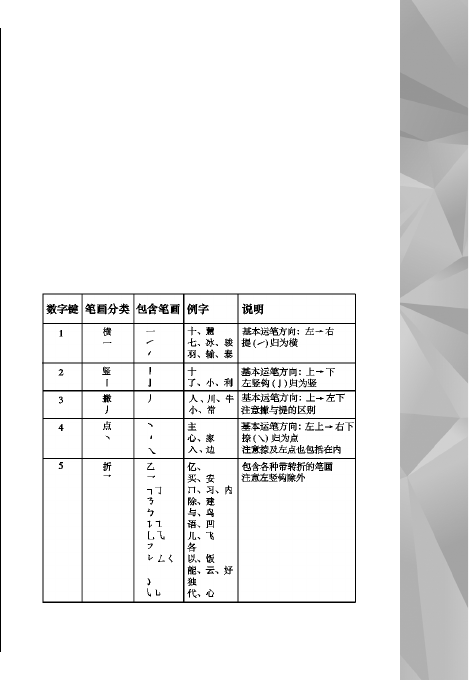
character and then press the scroll key to input
it.
When you do not need the predictive list or you
could not find your desired Chinese character in
the predictive list, while the predictive list is not
activated, you could directly input the Pinyin for
next Chinese character. While the predictive list
is already activated, you have to press the right
selection key to close the predictive list first and
then continue to input the Pinyin for the next
Chinese character.
Pinyin input example: To input
characters for "Pinyin"
1. Enter into the text editing window for writing a
text message or any other possible position for
inputting Chinese character, and switch to
Pinyin input mode.
2. Input the Pinyin letter pin for "pin": press 7, 4,
6 in sequence, and finally input * once for the 1st
tone.
3. Scroll right to highlight pin- and then press the
scroll key to activate the candidate list.
4. The character for "pin" will be shown in the
candidate list. If this character locates in the first
highlighted position of the candidate list, you
could directly press the scroll key to input it,
otherwise, you should first scroll right to
highlight this character and then press the scroll
key to input it.
5. After you input the character for "pin", the
predictive list will be shown, and the character
for "yin" is shown in the predictive list. You could
use the same method described in item 4 to
input this character.
Stroke input method
The strokes are classified according to the following
table.
101
Write text

Use Stroke input method
1. Input strokes: The strokes constituting Chinese
characters have been divided into five
categories: Horizontal, Vertical, Left-falling, Dot
and Turning. Each category corresponds to a
number key respectively 1, 2, 3, 4, 5.
You could press the number keys to input the
strokes according to the standard stroke order.
When you start inputting, the Chinese input
window will be shown on the screen, which
shows your input strokes and the candidate
Chinese characters matching to your input
strokes.
If you are not sure about a certain stroke
classification, press 6 as a substitution for that
stroke, then continue with the subsequent
strokes. A question mark appears in the input
area to represent that stroke.
Tip: Press the right selection key to close
the Chinese input window.
2. Input Chinese character: The first character in
the candidate list is highlighted, press the scroll
key to input this character. If your desired
character does not locate in the first position of
the candidate list, you should scroll right to
activate the candidate list (the candidates in the
list will have numbering on it, and the second
character will be highlighted), then you could
either press the number key matching to the
character numbering to input it, or scroll in the
relevant direction to find and highlight your
desired character and then press the scroll key
to input it.
While your input candidate is inserted in the text
input window, the Chinese input window will be
closed and the predictive list will be shown at
the same time. When the candidate list exceeds
one line, there will be up and down arrows
showing at the right end of the candidate list,
you could scroll up or down to view the previous
or next line of the candidate list, while the
candidate list is not activated, so you could still
revise your input strokes during viewing.
3. Input predictive character: If the current line of
the predictive list does not show your desired
character, scroll down to view the next line of
the predictive list. Find your desired character, if
it locates in the 1st highlighted position of the
predictive list, you could directly press the scroll
key to input it, otherwise, you have to scroll right
to activate the predictive list (the characters in
the list will have numbering, and the second
character will be highlighted), then you could
either press the number key matching to the
predictive character numbering to input it, or
scroll to your desired predictive character and
then press the scroll key to input it.
102
Write text

When you do not need the predictive list or you
could not find your desired Chinese character in
the predictive list, while the predictive list is not
activated, you could directly input the strokes for
next Chinese character. While the predictive list
is already activated, you have to press the right
selection key to close the predictive list first and
then continue to input the strokes for next
Chinese character.
Stroke input example: To input
characters for "birthday"
1. Enter into the text editing window for writing
text message or any other possible position for
inputting Chinese character, and switch to
stroke input mode.
2. Input the strokes for "birth": Press 3, 1, 1 in
sequence.
3. The character for "birth" will be shown in the
candidate list. If this character locates in the first
highlighted position of the list, you could
directly press the scroll key to input it, otherwise,
you have to first scroll right to find and highlight
this character and then press the scroll key to
input it.
4. After inputting the character for "birth", the
predictive list will be shown. The character "day"
is shown in the predictive list, and you could use
the same method described in item 3 to input it.
Insert special characters and
punctuation marks in
Chinese input mode
1. First close the Chinese input window, and then
press and hold * to open a list of special
characters and punctuation marks.
2. Scroll in the relevant direction (up, down, left or
right) to reach and highlight your needed special
character or punctuation mark, and press the
scroll key to enter it.
Traditional text input
Press a number key (1–9) repeatedly until the
desired character appears. There are more
characters available for a number key than are
printed on the key.
If the next letter is located on the same key as the
present one, wait until the cursor appears (or scroll
right to end the time-out period), and enter the
letter.
To insert a space, press 0. To move the cursor to the
next line, press 0 three times.
103
Write text

Predictive text input
With predictive input, you can enter any letter with
a single keypress. Predictive text input is based on
a built-in dictionary to which you can add new
words.
1. To turn predictive text input on or off in the
general settings, press , and select Tools >
Settings > General > Personalisation >
Language > Predictive text.
2. To write the desired word, press the keys 2–9.
Press each key only once for one letter. For
example, to write "Nokia" when the English
dictionary is selected, press 6 for N, 6 for o, 5 for
k, 4 for i, and 2 for a.
The word suggestion changes after each
keypress.
3. When you finish writing the word correctly,
scroll right to confirm it, or press 0 to add a
space.
If the word is not correct, press * repeatedly to
view the matching words the dictionary has
found one by one.
If the ? character is shown after the word, the
word is not in the dictionary. To add a word to
the dictionary, select Spell, enter the word using
traditional text input, and select OK. The word is
added to the dictionary. When the dictionary is
full, a new word replaces the oldest added word.
4. Start writing the next word.
Tips on text input
To insert a number in the letter mode, press and
hold the desired number key.
To switch between the different character modes,
press #.
To delete a character, press C. To delete more than
one character, press and hold C.
The most common punctuation marks are available
under 1. To scroll them through one by one, if you
use traditional text input, press 1 repeatedly. If you
use predictive text input, press 1, and then *
repeatedly.
To open a list of special characters, press and hold
*.
Tip: To select several special characters from
the special characters list, press 5 after each
highlighted character.
104
Write text

Messaging
Only devices that have compatible features can
receive and display multimedia messages. The
appearance of a message may vary depending on
the receiving device.
Messaging main view
Press , and select Messaging (network service).
To create a new message, select New message.
Messaging contains the following folders:
● Inbox — Received messages, except e-mail
and cell broadcast messages, are stored here.
● My folders — Organise your messages into
folders.
Tip: To avoid rewriting messages that you
send often, use texts in the Templates folder
in My folders. You can also create and save
your own templates.
● New mailbox — Connect to your remote
mailbox to retrieve your new e-mail messages,
or view your previously retrieved e-mail
messages offline.
● Drafts — Draft messages that have not been
sent are stored here.
● Sent — The last messages that have been
sent, excluding messages sent using Bluetooth
connectivity, are stored here. You can change the
number of messages to save in this folder.
● Outbox — Messages waiting to be sent are
temporarily stored in the outbox, for example,
when your device is outside network coverage.
● Reports — You can request the network to
send you a delivery report of the text messages
and multimedia messages you have sent
(network service).
To enter and send service requests (also known as
USSD commands), such as activation commands for
network services, to your service provider, select
Options > Service commands in the Messaging
main view.
Cell broadcast (network service) allows you to
receive messages on various topics, such as
weather or traffic conditions, from your service
provider. For available topics and relevant topic
numbers, contact your service provider. In the
Messaging main view, select Options > Cell
broadcast.
105
Messaging
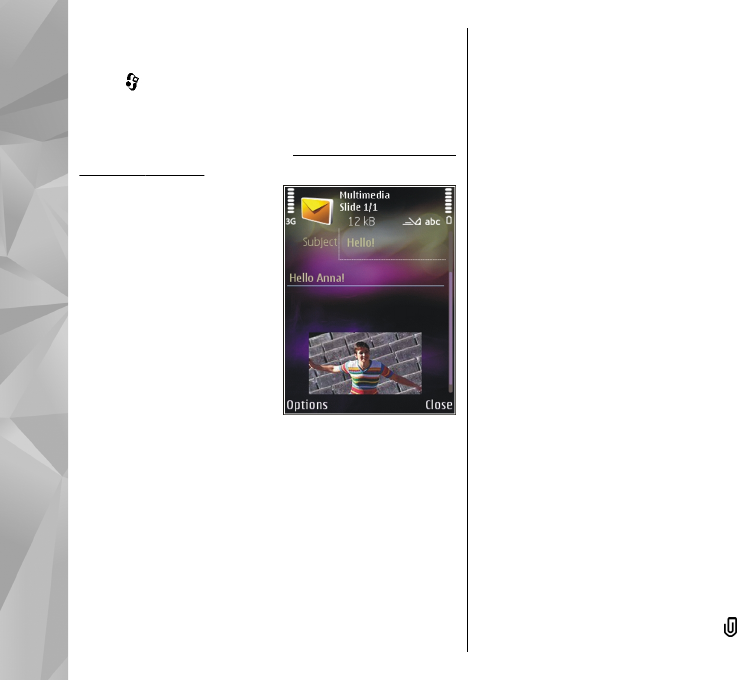
Write and send messages
Press , and select Messaging.
Before you can create a multimedia message or
write an e-mail, you must have the correct
connection settings in place. See "Define the e-mail
settings", p. 108.
The wireless network may
limit the size of MMS
messages. If the inserted
picture exceeds this limit,
the device may make it
smaller so that it can be
sent by MMS.
Check the size limit of e-
mail messages with your
service provider. If you
attempt to send an e-mail
message that exceeds the
size limit of the e-mail server, the message is left in
the Outbox folder, and the device attempts to
resend it periodically. Sending an e-mail requires a
data connection, and continuous attempts to
resend the e-mail may increase your phone bill. In
the Outbox folder, you can delete such a message
or move it to the Drafts folder.
1. Select New message > Message to send a text
message or a multimedia message (MMS), Audio
message to send an audio message (a
multimedia message that includes one sound
clip), or E-mail to send an e-mail.
2. In the To field, press the scroll key to select
recipients or groups from contacts, or enter the
recipient’s phone number or e-mail address. To
add a semicolon (;) that separates the recipients,
press *. You can also copy and paste the number
or address from the clipboard.
3. In the Subject field, enter the subject of the e-
mail. To change the fields that are visible, select
Options > Message header fields.
4. In the message field, write the message. To
insert a template or note, select Options >
Insert > Insert text > Template or Note.
5. To add a media object to a multimedia message,
select Options > Insert, the object type or
source, and the desired object. To insert a
business card, slide, note, or some other file to
the message, select Options > Insert > Insert
other.
6. To capture an image or record video or sound for
a multimedia message, select Options >
Insert > Insert image > New, Insert video
clip > New, or Insert sound clip > New .
7. To add an attachment to an e-mail, select
Options > Insert > Image, Sound clip, Video
clip, Note, or Other for other file types. E-mail
attachments are indicated by .
106
Messaging

8. To send the message, select Options > Send,
or press the call key.
Note: Your device may indicate that your
message was sent to the message center number
programmed into your device. Your device may not
indicate whether the message is received at the
intended destination. For more details about
messaging services, contact your service provider.
Your device supports the sending of text messages
beyond the character limit for a single message.
Longer messages are sent as a series of two or more
messages. Your service provider may charge
accordingly. Characters that use accents or other
marks, and characters from some language options,
take up more space, limiting the number of
characters that can be sent in a single message.
You may not be able to send video clips that are
saved in the .mp4 format or that exceed the size
limit of the wireless network in a multimedia
message.
Tip: You can combine images, video, sound,
and text to a presentation and send it in a
multimedia message. Start to create a
multimedia message, and select Options >
Insert > Insert presentation. The option is
shown only if MMS creation mode is set to
Guided or Free. See "Multimedia message
settings", p. 111.
Messaging inbox
Receive messages
Press , and select Messaging > Inbox.
In the Inbox folder, indicates an unread text
message, an unread multimedia message, an
unread audio message, and data received
through Bluetooth connectivity.
When you receive a message, and 1 new
message are shown in the standby mode. To open
the message, select Show. To open a message in
Inbox, scroll to it, and press the scroll key. To reply
to a received message, select Options > Reply.
Multimedia messages
Important: Exercise caution when opening
messages. Multimedia message objects may
contain malicious software or otherwise be harmful
to your device or PC.
You may receive a notification that a multimedia
message is waiting in the multimedia message
centre. To start a packet data connection to retrieve
the message to your device, select Options >
Retrieve.
When you open a multimedia message ( ), you
may see an image and a message. is shown if
107
Messaging
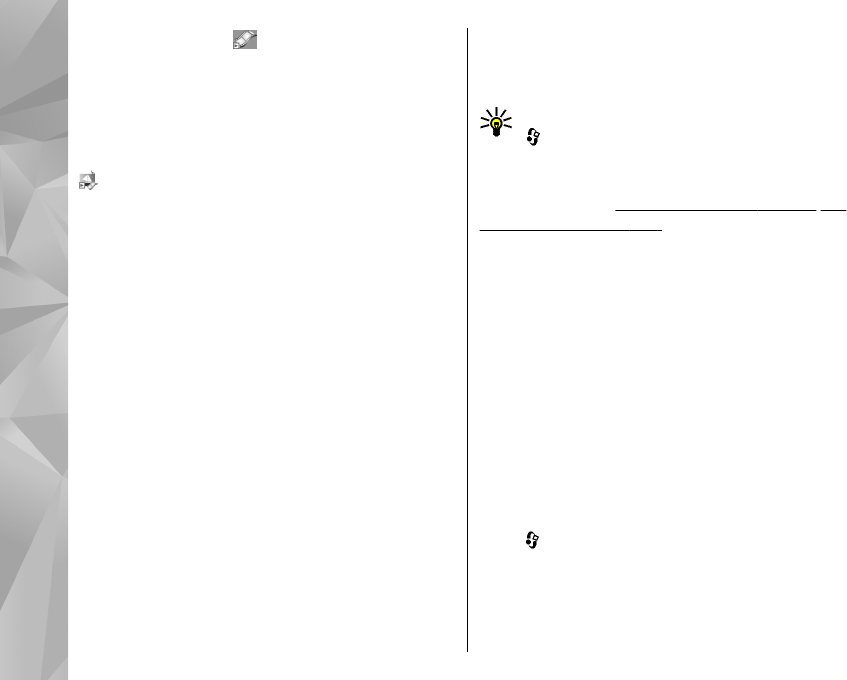
sound is included, or if video is included. To play
the sound or the video, select the indicator.
To see the media objects that have been included
in the multimedia message, select Options >
Objects.
If the message includes a multimedia presentation,
is displayed. To play the presentation, select the
indicator.
Data, settings, and web service
messages
Your device can receive many kinds of messages
that contain data, such as business cards, ringing
tones, operator logos, calendar entries, and e-mail
notifications. You may also receive settings from
your service provider or company information
management department in a configuration
message.
To save the data from the message, select
Options and the corresponding option.
Web service messages are notifications (for
example, news headlines) and may contain a text
message or a link. For availability and subscription,
contact your service provider.
Mailbox
Define the e-mail settings
Tip: To define your mailbox settings, press
, and select Messaging > Mailboxes.
To use e-mail, you must have a valid internet access
point (IAP) in the device and define your e-mail
settings correctly. See "Access points", p. 145. See
"E-mail settings", p. 112.
You must have a separate e-mail account. Follow
the instructions given by your remote mailbox and
internet service provider (ISP).
If you select New mailbox in the Messaging main
view and have not set up your e-mail account, you
are prompted to do so. To start creating the e-mail
settings with the mailbox guide, select Start.
When you create a new mailbox, the name you give
to the mailbox replaces New mailbox in the
Messaging main view. You can have up to six
mailboxes.
Open the mailbox
Press , and select Messaging and a mailbox.
When you open the mailbox, the device asks if you
want to connect to the mailbox (Connect to
mailbox?).
108
Messaging
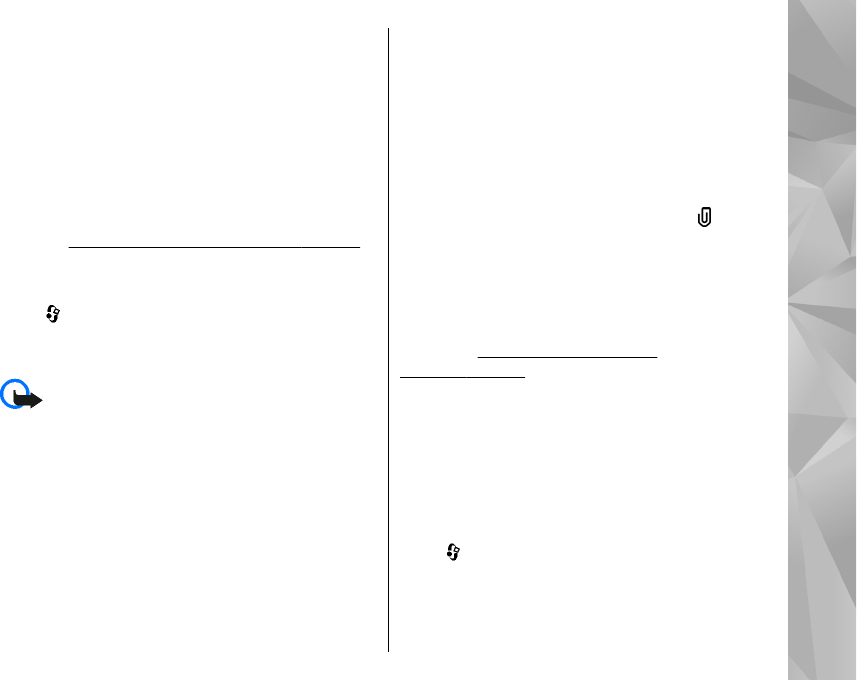
To connect to your mailbox and retrieve new e-mail
headings or messages, select Yes. When you view
messages online, you are continuously connected
to a remote mailbox using a data connection.
To view previously retrieved e-mail messages
offline, select No.
To create a new e-mail message, select New
message > E-mail in the Messaging main view or
Options > Create message > E-mail in your
mailbox. See "Write and send messages", p. 106.
Retrieve e-mail messages
Press , and select Messaging and a mailbox.
If you are offline, select Options > Connect to start
a connection to the remote mailbox.
Important: Exercise caution when opening
messages. E-mail messages may contain malicious
software or otherwise be harmful to your device or
PC.
1. When you have an open connection to a remote
mailbox, select Options > Retrieve e-mail >
New to retrieve all new messages, Selected to
retrieve only the messages that have been
marked, or All to retrieve all messages from the
mailbox.
To stop retrieving messages, select Cancel.
2. To close the connection and view the e-mail
messages offline, select Options >
Disconnect.
3. To open an e-mail message, press the scroll key.
If the e-mail message has not been retrieved and
you are offline, you are asked if you want to
retrieve this message from the mailbox.
To view e-mail attachments, open the message, and
select the attachment field indicated by . If the
attachment has a dimmed indicator, it has not been
retrieved to the device; select Options >
Retrieve.
To retrieve e-mail messages automatically, select
Options > E-mail settings > Automatic
retrieval. See "Automatic retrieval
settings", p. 113.
Setting the device to retrieve e-mail automatically
may involve the transmission of large amounts of
data through your service provider's network.
Contact your service provider for information about
data transmission charges.
Delete e-mail messages
Press , and select Messaging and a mailbox.
To delete the contents of an e-mail message from
the device while still retaining it in the remote
mailbox, select Options > Delete. In Delete e-
mail from:, select Phone only.
109
Messaging

The device mirrors the e-mail headings in the
remote mailbox. Although you delete the message
content, the e-mail heading stays in your device. If
you want to remove the heading as well, you must
first delete the e-mail message from your remote
mailbox, then make a connection from your device
to the remote mailbox again to update the status.
To delete an e-mail from the device and the remote
mailbox, select Options > Delete > Phone and
server.
To cancel deleting an e-mail from the device and
server, scroll to an e-mail that has been marked to
be deleted during the next connection , and
select Options > Restore.
Disconnect from the mailbox
When you are online, to end the data connection to
the remote mailbox, select Options >
Disconnect.
View messages on a SIM card
Press , and select Messaging.
Before you can view SIM messages, you must copy
them to a folder in your device.
1. In the Messaging main view, select Options >
SIM messages.
2. Select Options > Mark/Unmark > Mark or
Mark all to mark messages.
3. Select Options > Copy. A list of folders opens.
4. To start copying, select a folder and OK. To view
the messages, open the folder.
Messaging settings
The settings may be preconfigured in your device,
or you may receive them in a message. To enter
settings manually, fill in all fields marked with Must
be defined or an asterisk.
Some or all message centres or access points may
be preset for your device by your service provider,
and you may not be able to change, create, edit, or
remove them.
Text message settings
Press , and select Messaging > Options >
Settings > Text message.
Select from the following:
●Message centres — View a list of all text
message centres that have been defined.
●Message centre in use — Select which message
centre to use to deliver text messages.
●Character encoding — To use character
conversion to another encoding system when
available, select Reduced support.
110
Messaging

●Receive report — Select whether the network
sends delivery reports on your messages
(network service).
●Message validity — Select how long the
message centre resends your message if the first
attempt fails (network service). If the message
cannot be sent within the validity period, the
message is deleted from the message centre.
●Message sent as — Contact your service
provider to learn if your message centre is able
to convert text messages into these other
formats.
●Preferred connection — Select the connection
to use.
●Reply via same centre — Select whether you
want the reply message to be sent using the
same text message centre number (network
service).
Multimedia message settings
Press , and select Messaging > Options >
Settings > Multimedia message.
Select from the following:
●Image size — Define the size of the image in a
multimedia message.
●MMS creation mode — If you select Guided, the
device informs you if you try to send a message
that may not be supported by the recipient. If you
select Restricted, the device prevents you from
sending messages that may not be supported. To
include content in your messages without
notifications, select Free.
●Access point in use — Select which access point
is used as the preferred connection.
●Multimedia retrieval — Select how you want
to receive messages. To receive messages
automatically in your home cellular network,
select Auto in home netw.. Outside your home
cellular network, you receive a notification that
there is a message to retrieve in the multimedia
message centre.
Outside your home cellular network, sending and
receiving multimedia messages may cost you more.
If you select Multimedia retrieval > Always
automatic, your device automatically makes an
active packet data connection to retrieve the
message both in and outside your home cellular
network.
●Allow anonymous msgs. — Select whether you
want to reject messages from an anonymous
sender.
●Receive adverts — Define whether you want to
receive multimedia message advertisements.
●Receive reports — Select whether you want the
status of the sent message to be shown in the log
(network service).
111
Messaging

●Deny report sending — Select whether you
want to prevent your device from sending
delivery reports of received messages.
●Message validity — Select for how long the
message centre resends your message if the first
attempt fails (network service). If the message
cannot be sent within this time period, the
message is deleted from the message centre.
E-mail settings
Manage mailboxes
Press , and select Messaging > Options >
Settings > E-mail.
To select which mailbox you want to use to send e-
mail, select Mailbox in use and a mailbox.
To remove a mailbox and its messages from your
device, select Mailboxes, scroll to the desired
mailbox, and press C.
To create a new mailbox, in Mailboxes, select
Options > New mailbox. The name you give to
the new mailbox replaces New mailbox in the
Messaging main view. You can have up to six
mailboxes.
Select Mailboxes and a mailbox to change the
connection settings, user settings, retrieval
settings, and automatic retrieval settings.
Connection settings
Press , and select Messaging > Options >
Settings > E-mail > Mailboxes, a mailbox, and
Connection settings.
To edit the settings for the e-mail you receive, select
Incoming e-mail, and from the following:
●User name — Enter your user name given to you
by your service provider.
●Password — Enter your password. If you leave
this field blank, you are prompted for the
password when you try to connect to your
remote mailbox.
●Incoming mail server — Enter the IP address
or host name of the mail server that receives your
e-mail.
●Access point in use — Select an internet access
point (IAP). See "Access points", p. 145.
●Mailbox name — Enter a name for the mailbox.
●Mailbox type — Defines the e-mail protocol that
your remote mailbox service provider
recommends. The options are POP3 and IMAP4.
This setting cannot be changed.
●Security — Select the security option used to
secure the connection to the remote mailbox.
●Port — Define a port for the connection.
●APOP secure login (for POP3 only) — Use with
the POP3 protocol to encrypt the sending of
passwords to the remote e-mail server while
connecting to the mailbox.
112
Messaging
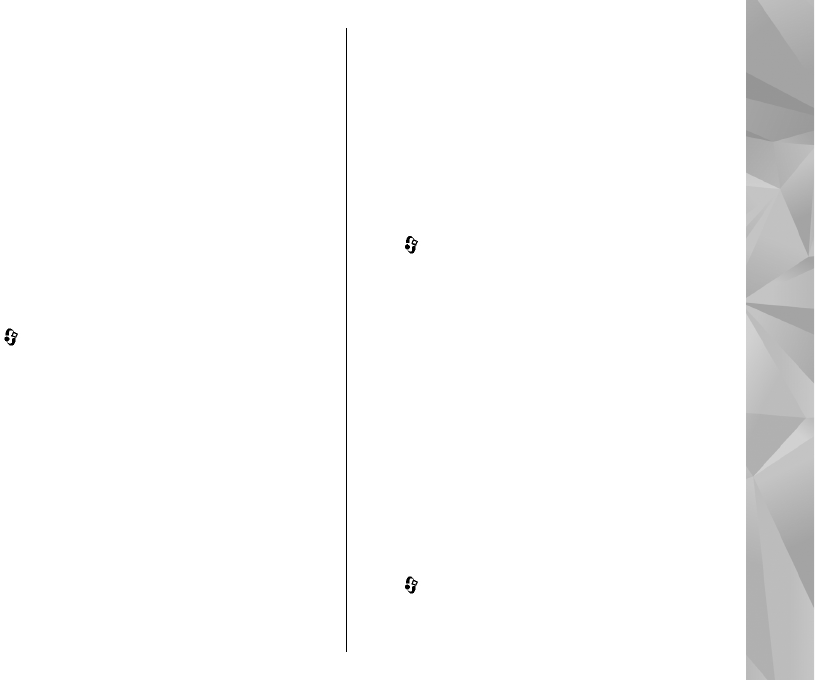
To edit the settings for the e-mail you send, select
Outgoing e-mail and from the following:
●My e-mail address — Enter the e-mail address
given to you by your service provider.
●Outgoing mail server — Enter the IP address or
host name of the mail server that sends your e-
mail. You may only be able to use the outgoing
server of your service provider. Contact your
service provider for more information.
The settings for User name, Password, Access
point in use, Security, and Port are similar to the
ones in Incoming e-mail.
User settings
Press , and select Messaging > Options >
Settings > E-mail > Mailboxes, a mailbox, and
User settings.
Select from the following:
●My name — Enter your own name. Your name
replaces your e-mail address in the recipient’s
device when the recipient’s device supports this
function.
●Send message — Define how e-mail is sent from
your device. Select Immediately for the device
to connect to the mailbox when you select Send
message. If you select During next conn., e-
mail is sent when the connection to the remote
mailbox is available.
●Send copy to self — Select whether you want
to send a copy of the e-mail to your own mailbox.
●Include signature — Select whether you want
to attach a signature to your e-mail messages.
●New e-mail alerts — Select whether you want
to receive the new e-mail indications (a tone, a
note, and a mail indicator) when new mail is
received.
Retrieval settings
Press , and select Messaging > Options >
Settings > E-mail > Mailboxes, a mailbox, and
Retrieval settings.
Select from the following:
●E-mail retrieval — Define which parts of the e-
mail are retrieved: Headers only, Size limit
(POP3), or Msgs. & attachs. (POP3).
●Retrieval amount — Define how many new e-
mail messages are retrieved to the mailbox.
●IMAP4 folder path (for IMAP4 only) — Define
the folder path for folders to be subscribed.
●Folder subscriptions (for IMAP4 only)
— Subscribe to other folders in the remote
mailbox, and retrieve content from those folders.
Automatic retrieval settings
Press , and select Messaging > Options >
Settings > E-mail > Mailboxes, a mailbox, and
Automatic retrieval.
113
Messaging

Select from the following:
●E-mail notifications — To automatically
retrieve the headings to your device when you
receive new e-mail in your remote mailbox,
select Auto-update or Only in home netw..
●E-mail retrieval — To automatically retrieve the
headings of new e-mail messages from your
remote mailbox at defined times, select
Enabled or Only in home netw.. Define when
and how often the messages are retrieved.
E-mail notifications and E-mail retrieval cannot
be active at the same time.
Setting the device to retrieve e-mail automatically
may involve the transmission of large amounts of
data through your service provider's network.
Contact your service provider for information about
data transmission charges.
Web service message settings
Press , and select Messaging > Options >
Settings > Service message.
Select whether you want to receive service
messages. If you want to set the device to
automatically activate the browser and start a
network connection to retrieve content when you
receive a service message, select Download
messages > Automatically.
Cell broadcast settings
Check the available topics and related topic
numbers with your service provider.
Press , and select Messaging > Options >
Settings > Cell broadcast.
Select from the following:
●Reception — Select whether you want to
receive cell broadcast messages.
●Language — Select the languages in which you
want to receive messages: All, Selected, or
Other.
●Topic detection — Select whether the device
automatically searches for new topic numbers,
and saves the new numbers without a name to
the topic list.
Other settings
Press , and select Messaging > Options >
Settings > Other.
Select from the following:
●Save sent messages — Select whether you
want to save a copy of the text messages,
multimedia messages, or e-mail that you send to
the Sent folder.
●Number of saved msgs. — Define how many
sent messages are saved to the sent folder at a
114
Messaging

time. When the limit is reached, the oldest
message is deleted.
●Memory in use — Select the memory where you
want to save your messages.
115
Messaging

Make calls
Calls
1. In the standby mode, enter the phone number,
including the area code. To remove a number,
press C.
For international calls, press * twice for the +
character (which replaces the international
access code), and enter the country code, area
code (omit the leading zero if necessary), and
phone number.
2. To end the call, press the call key.
3. To end the call (or to cancel the call attempt),
press the end key.
Pressing the end key always ends a call, even if
another application is active.
To make a call from Contacts, press , and select
Contacts. Scroll to the desired name, or enter the
first letters of the name to the search field. Matching
contacts are listed. To call, press the call key. If you
have saved several numbers for a contact, select the
desired number from the list, and press the call key.
Options during a call
To adjust the volume during a call, use the volume
key on the side of your device. You can also use the
scroll key. If you have set the volume to Mute, select
Unmute first.
Press the call key to send the file to a compatible
device (network service).
To put an active voice call on hold while answering
another incoming call, select Options > Hold. To
switch between the active and the held call, select
Options > Swap.
To send DTMF tone strings (for example, a
password), select Options > Send DTMF. Enter the
DTMF string or search for it in Contacts. To enter a
wait character (w) or a pause character (p), press *
repeatedly. To send the tone, select OK. You can add
DTMF tones to the phone number or DTMF fields in
a contact card.
Tip: When you have only one active voice call,
to put the call on hold, press the call key. To
activate the call, press the call key again.
During an active call, to route the sound from the
handset to the loudspeaker, select Options >
116
Make calls

Activate loudspeaker. If you have attached a
compatible headset with Bluetooth connectivity, to
route the sound to the headset, select Options >
Activate handsfree. To switch back to the handset,
select Options > Activate handset.
To end an active call and replace it by answering the
waiting call, select Options > Replace.
If you have several calls active, to end them all,
select Options > End all calls.
Many of the options that you can use during a voice
call are network services.
Voice mailbox
To call your voice mailbox (network service), in the
standby mode, press and hold 1.
To change the phone number of your voice mailbox,
press , and select Tools > Utilities > Call
mailbox, a mailbox, and Options > Change
number. Enter the number (obtained from your
network service provider), and select OK.
Answer or decline a call
To answer the call, press the call key.
To mute the ringing tone of an incoming call, select
Silence.
If you do not want to answer a call, press the end
key. If you activate the Call divert > Voice calls >
If busy function in phone settings to divert calls,
declining an incoming call also diverts the call.
When you select Silence to mute the ringing tone
of an incoming call, you can send a text message
without rejecting the call, informing the caller that
you cannot answer the call. Select Options > Send
message. To set up this option and write a standard
text message, select Tools > Settings > Phone >
Call > Reject call with message.
Make a conference call
1. Make a call to the first participant.
2. To make a call to another participant, select
Options > New call. The first call is
automatically put on hold.
3. When the new call is answered, to join the first
participant in the conference call, select
Options > Conference.
To add a new person to the call, repeat step 2,
and select Options > Conference > Add to
conference. Your device supports conference
calls between a maximum of six participants,
including yourself.
To have a private conversation with one of the
participants, select Options > Conference >
117
Make calls

Private. Select a participant, and select
Private. The conference call is put on hold on
your device. The other participants can still
continue the conference call. After you finish the
private conversation, select Options >
Conference to return to the conference call. If
there are more than three participants in the
conference call, select Options > Conference >
Add to conference to finish the private
conversation.
To drop a participant, select Options >
Conference > Drop participant, scroll to the
participant, and select Drop.
4. To end the active conference call, press the end
key.
Speed dial a phone number
To activate the feature, press , and select Tools >
Settings > Phone > Call > Speed dialling.
To assign a phone number to one of the number
keys (2-9), press , and select Tools > Utilities >
Speed dial. Scroll to the key to which you want to
assign the phone number, and select Options >
Assign. 1 is reserved for the voice mailbox, and for
starting the web browser.
To call in the standby mode, press the assigned key
and the call key.
Call waiting
You can answer a call while you have another call in
progress if you have activated call waiting in
Settings > Phone > Call > Call waiting
(network service).
To answer the waiting call, press the call key. The
first call is put on hold.
To switch between the two calls, select Swap. To
end the active call, press the end key. To end both
calls, select Options > End all calls.
Voice dialling
Your device supports enhanced voice commands.
Enhanced voice commands are not dependent on
the speaker’s voice, so the user does not record
voice tags in advance. Instead, the device creates a
voice tag for the entries in contacts, and compares
the spoken voice tag to it. The voice recognition in
the device adapts to the main user’s voice to
recognise the voice commands better.
The voice tag for a contact is the name or nickname
that is saved on the contact card. To listen to the
synthesised voice tag, open a contact card, and
select Options > Play voice tag.
118
Make calls
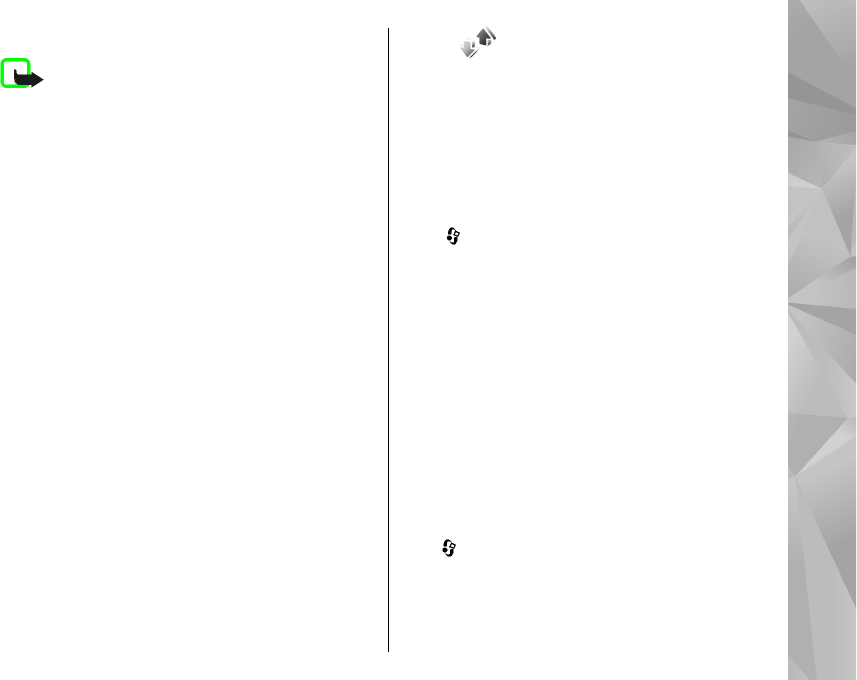
Make a call with a voice tag
Note: Using voice tags may be difficult in a
noisy environment or during an emergency, so you
should not rely solely upon voice dialing in all
circumstances.
When you use voice dialling, the loudspeaker is in
use. Hold the device at a short distance away when
you say the voice tag.
1. To start voice dialling, in the standby mode,
press and hold the right selection key. If a
compatible headset with the headset key is
attached, press and hold the headset key to start
voice dialling.
2. A short tone is played, and Speak now is
displayed. Say clearly the name or nickname that
is saved on the contact card.
3. The device plays a synthesised voice tag for the
recognised contact in the selected device
language, and displays the name and number.
After a time-out of 2.5 seconds, the device dials
the number. If the recognised contact was not
correct, select Next to view a list of other
matches or Quit to cancel voice dialling.
If several numbers are saved under the name, the
device selects the default number if it has been set.
If not, the device selects the first available number
in a contact card.
Log
The log stores information about the
communication history of the device. The device
registers missed and received calls only if the
network supports these functions, the device is
switched on, and within the network service area.
Recent calls
Press , and select Tools > Log.
To monitor the phone numbers of missed, received,
and dialled voice calls, select Recent calls. The
device registers missed and received calls only if the
network supports these functions, the device is
switched on, and within the network service area.
To clear all recent call lists, select Options > Clear
recent calls in the recent calls main view. To clear
one of the call registers, open the register you want
to erase, and select Options > Clear list. To clear
an individual event, open a register, scroll to the
event, and press C.
Call duration
Press , and select Tools > Log.
To monitor the approximate duration of your
incoming and outgoing calls, select Call duration.
119
Make calls
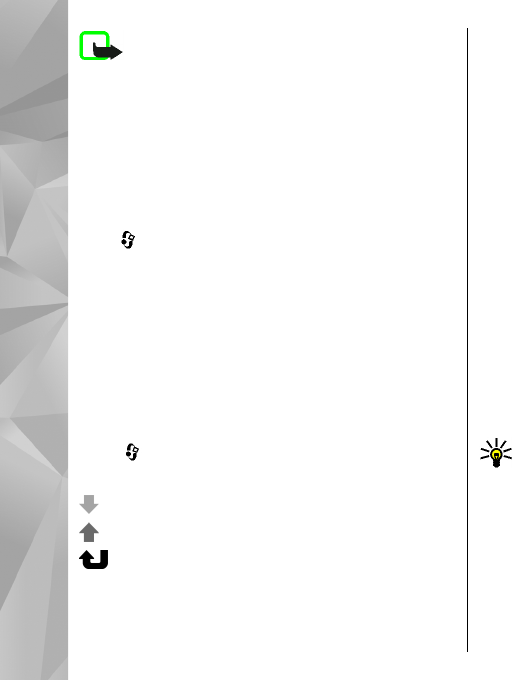
Note: The actual time invoiced for calls by
your service provider may vary, depending on
network features, rounding off for billing, and so
forth.
To clear call duration timers, select Options >
Clear timers. For this you need the lock code.
Packet data
Press , and select Tools > Log.
To check the amount of data sent and received
during packet data connections, select Packet
data. For example, you may be charged for your
packet data connections by the amount of data sent
and received.
Monitor all communication
events
Press , and select Tools > Log > Recent calls.
Icons in the log are as follows:
Incoming
Outgoing
Missed communication events
To open the general log where you can monitor all
voice calls, text messages, or data connections
registered by the device, scroll right. Subevents,
such as a text message sent in more than one part
and packet data connections, are logged as one
communication event. Connections to your
mailbox, multimedia messaging centre, or web
pages are shown as packet data connections.
To add an unknown phone number from the log to
your contacts, select Options > Save to Contacts.
To filter the log, select Options > Filter and a filter.
To erase the contents of the log, recent calls
register, and messaging delivery reports
permanently, select Options > Clear log. Select
Yes to confirm. To remove a single event from one
of the recent calls logs, press C.
To set the log duration, select Options >
Settings > Log duration. If you select No log, all
the log contents, recent calls register, and
messaging delivery reports are permanently
deleted.
Tip: In the details view, you can copy a phone
number to the clipboard, and paste it into a
text message, for example. Select Options >
Copy number.
To view from the packet data counter how much
data is transferred and how long a certain packet
data connection lasts, scroll to an incoming or
outgoing event indicated by Pack., and select
Options > View details.
120
Make calls
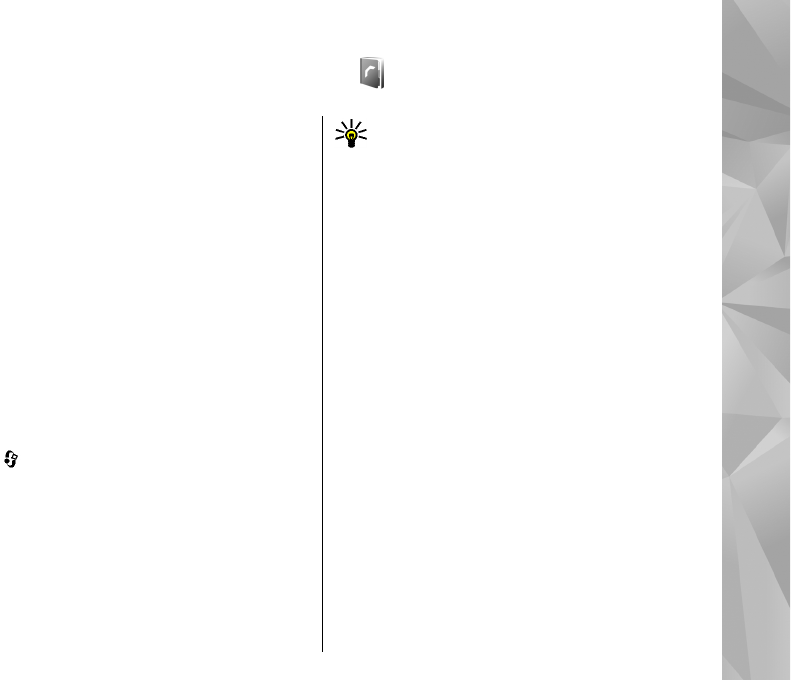
Contacts (phonebook)
In Contacts, you can save and update contact
information, such as phone numbers, home
addresses, or e-mail addresses of your contacts. You
can add a personal ringing tone or a thumbnail
image to a contact card. You can also create contact
groups, which allow you to send text messages or
e-mail to many recipients at the same time.
The device functions that display names use the
phone number that most closely matches. If less
than 7 digits match, the name displayed may not be
correct.
Save and edit names and
numbers
1. Press , and select Contacts > Options >
New contact.
2. Fill in the fields that you want, and select Done.
To edit contact cards, scroll to the contact card you
want to edit, and select Options > Edit. You can
also search for the desired contact by entering the
first letters of the name to the search field. A list of
the contacts starting with the letters appear on the
display.
Tip: To add and edit contact cards, you can
also use Nokia Contacts Editor available in
Nokia Nseries PC Suite.
To attach a small thumbnail image to a contact card,
open the contact card, and select Options > Edit >
Options > Add thumbnail. The thumbnail image
is shown when the contact calls.
Manage names and numbers
To add a contact to a group, select Options > Add
to group (shown only if you have created a group).
To check to which groups a contact belongs, select
the contact and Options > Belongs to groups.
To delete a contact card, select a card, and press C.
To delete several contact cards at the same time,
select Options > Mark/Unmark to mark the
desired contact cards, and press C to delete.
To send contact information, select the card you
want to send, Options > Send, and the desired
option.
To listen to the voice tag assigned to the contact,
select a contact card and Options > Play voice
tag.
121
Contacts (phonebook)

Default numbers and
addresses
Press , and select Contacts.
You can assign default numbers or addresses to a
contact card. In this way if a contact has several
numbers or addresses, you can easily call or send a
message to the contact to a certain number or
address. The default number is also used in voice
dialling.
1. In the contacts list, select a contact.
2. Select Options > Defaults.
3. Select a default to which you want to add a
number or an address, and select Assign.
4. Select a number or an address you want to set
as a default.
The default number or address is underlined in the
contact card.
Add ringing tones for
contacts
Press , and select Contacts.
To define a ringing tone for a contact or a contact
group, do the following:
1. Press the scroll key to open a contact card or go
to the groups list, and select a contact group.
2. Select Options > Ringing tone. A list of ringing
tones opens.
3. Select the ringing tone you want to use for the
individual contact or the members of the
selected group.
When a contact or group member calls you, the
device plays the chosen ringing tone (if the caller’s
telephone number is sent with the call and your
device recognises it).
To remove the ringing tone, select Default tone
from the list of ringing tones.
Copy contacts
When you open Contacts for the first time, you can
choose to copy SIM contacts to the device memory
or to view SIM contacts in the contacts directory. The
device asks you if you want to copy names and
numbers from a SIM card to your device.
To start copying, press OK.
Press Cancel if you do not want to copy the SIM
contacts to the device memory. The device asks you
if you want to view the SIM contacts in the contacts
directory. Press OK, Contacts opens and you can see
names stored on your SIM card marked with .
122
Contacts (phonebook)

SIM directory and other SIM
services
For availability and information on using SIM card
services, contact your SIM card vendor. This may be
the service provider or other vendor.
To see the names and numbers stored on the SIM
card, select Options > My numbers. In the SIM
directory you can add and edit contacts, and you can
make calls.
To view the list of fixed dialling numbers, select
Options > SIM numbers. This setting is only
shown if supported by your SIM card.
To restrict calls from your device to selected phone
numbers, select Options > Fixed dial contacts.
You need your PIN2 code to activate and deactivate
fixed dialling or edit your fixed dialling contacts.
Contact your service provider if you do not have the
code. To add new numbers to the fixed dialling list,
select Options > New SIM contact.
When you use fixed dialling, packet data
connections are not possible, except when sending
text messages over a packet data connection. In this
case, the message centre number and the
recipient’s phone number must be included on the
fixed dialling list.
When fixed dialling is activated, calls may be
possible to the official emergency number
programmed into your device.
Manage contact groups
Create contact groups
1. In Contacts, scroll right to open the groups list.
2. Select Options > New group.
3. Write a name for the group or use the default
name, and select OK.
4. Select the group and Options > Add
members.
5. Scroll to a contact, and press the scroll key to
mark it. To add multiple members at a time,
repeat this action on all the contacts you want
to add.
6. To add the contacts to the group, select OK.
To rename a group, select Options > Rename,
enter the new name, and select OK.
Remove members from a group
1. In the groups list, select the group you want to
modify.
2. Scroll to the contact, and select Options >
Remove from group.
123
Contacts (phonebook)

3. To remove the contact from the group, select
Yes.
124
Contacts (phonebook)
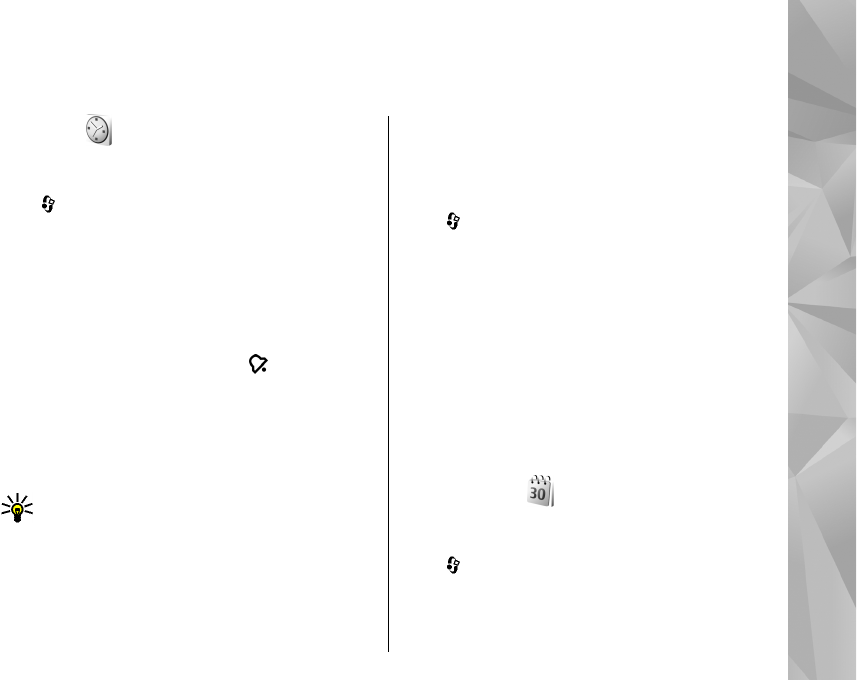
Time management
Clock
Alarm clock
Press , and select Applications > Clock.
To set a new quick alarm, select Options > New
quick alarm. Quick alarms are set for the next 24
hours and they cannot be repeated.
To view your active and inactive alarms, scroll right
to the alarm tab. To set a new alarm, select
Options > New alarm. Define the repetition, if
needed. When an alarm is active, is shown.
To turn off the sounding alarm, select Stop. To stop
the alarm for a certain time period, select Snooze.
If your device is switched off when an alarm is due,
your device switches itself on and starts sounding
the alarm tone.
Tip: To define the time period after which the
clock alarm sounds again when you set it to
snooze, select Options > Settings > Alarm
snooze time.
To cancel an alarm, select Options > Remove
alarm.
To change the time, date, and clock type settings,
select Options > Settings.
World clock
Press , and select Applications > Clock.
To open the world clock view, scroll right to the
world clock tab. In the world clock view, you can
view the time in different cities. To add cities to the
list, select Options > Add city. You can add a
maximum of 15 cities to the list.
To set your current city, scroll to a city, and select
Options > Set as current city. The city is displayed
in the clock main view, and the time in your device
is changed according to the city selected. Ensure
that the time is correct and matches your time zone.
Calendar
Create a calendar entry
Press , and select Applications > Calendar.
125
Time management

1. To add a new calendar
entry, scroll to the
desired date, and select
Options > New
entry and one of the
following:
●Meeting — to
remind you of an
appointment that
has a specific date
and time
●Memo — to write a
general entry for a day
●Anniversary — to remind you of birthdays or
special dates (entries are repeated annually)
●To-do — to remind you of a task that must be
done by a specific date
2. Fill in the fields. To set an alarm, select Alarm >
On, and enter the alarm time and date.
To add a description for an entry, select
Options > Add description.
3. To save the entry, select Done.
Tip: In the day, week, or month calendar
view, press any key (1-0). An appointment
entry opens, and the characters you enter are
added to the subject field. In the to-do view,
a to-do note entry opens.
When the calendar alarm sounds for a note, select
Silence to turn off the calendar alarm tone. The
reminder text stays on the screen. To stop the
calendar alarm, select Stop. To set the alarm to
snooze, select Snooze.
Tip: To define the time period after which the
calendar alarm sounds again when you set it
to snooze, press , and select
Applications > Calendar > Options >
Settings > Alarm snooze time.
Calendar views
To change the starting day of the week or the view
that is shown when you open the calendar, select
Options > Settings. In the settings, you can also
modify the calendar alarm tone, alarm snooze time,
and the title for the week view.
To go to a certain date, select Options > Go to
date. To jump to today, press #.
To switch between the month view, week view, day
view, and to-do view, press *.
To send a calendar note to a compatible device,
select Options > Send.
If the other device is not compatible with
Coordinated Universal Time (UTC), the time
information of received calendar entries may not be
displayed correctly.
126
Time management

Manage calendar entries
To delete several events at a time, go to the month
view, and select Options > Delete entry > Before
date or All entries.
To mark a task as completed, scroll to it in the to-do
view, and select Options > Mark as done.
You can synchronise your calendar with a
compatible PC using Nokia Nseries PC Suite. When
creating a calendar entry, set the desired
synchronisation option.
Lunar calendar
To use the Lunar calendar function, the device
language must be Chinese.
To view detailed Lunar calendar information of the
currently highlighted date:
1. In calendar views, select Options > Settings >
Lunar calendar, and set Lunar calendar item as
on.
2. When you go back to the calendar views, Lunar
information is displayed in the navigation pane.
To view more detailed Lunar information in a
pop-up window, select Options > View lunar
data. This option is displayed only when the
Lunar calendar setting item is on.
127
Time management

Office folder
Quickoffice
With the Quickoffice applications, you can
view .doc, .xls, .ppt, .pps, and .txt documents and
download software. Not all file formats or features
are supported. Apple Macintosh is not supported.
To view a file, press , and select Applications >
Office > Quickoffice. Select the location from
which you want to view files, browse to the desired
folder, and select a file.
The files open in the respective applications
depending on the file format.
To download software using Quickmanager, in the
main view, select Quickmanager; or, when
browsing files, scroll to the Quickmanager tab.
If you experience problems with the Quickoffice
applications, visit www.quickoffice.com, or send e-
mail to supportS60@quickoffice.com.
Quickword
With Quickword, you can view native Microsoft
Word documents with your device.
Quickword supports the viewing of documents
saved in .doc and .txt formats created with Microsoft
Word 97, 2000, XP, and 2003. Not all variations or
features of the mentioned file formats are
supported.
To upgrade to a version of Quickword that supports
editing, when you have a file open, select
Options > Updates and upgrades. The upgrade
is chargeable.
Quicksheet
With Quicksheet, you can view native Microsoft
Excel files with your device.
Quicksheet supports the viewing of spreadsheet
files saved in .xls format created with Microsoft
Excel 97, 2000, XP, or 2003. Not all variations or
features of the mentioned file formats are
supported.
To upgrade to a version of Quicksheet that supports
editing, when you have a file open, select
Options > Updates and upgrades. The upgrade
is chargeable.
128
Office folder
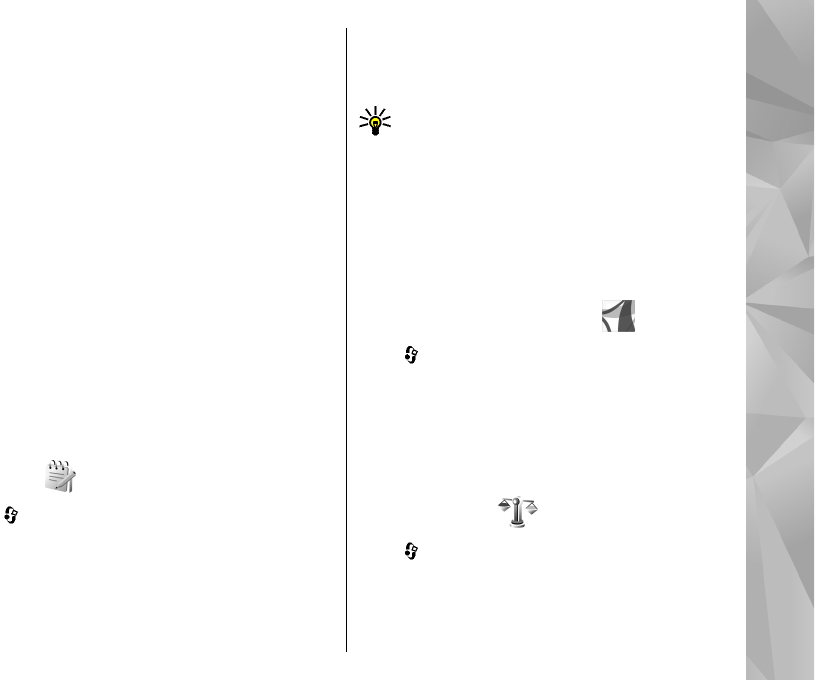
Quickpoint
With Quickpoint, you can view native Microsoft
PowerPoint presentations with your device.
Quickpoint supports the viewing of presentations
saved in .ppt and .pps formats created with
Microsoft PowerPoint 2000, XP, and 2003. Not all
variations or features of the mentioned file formats
are supported.
To upgrade to a version of Quickpoint that supports
editing, when you have a file open, select
Options > Updates and upgrades. The upgrade
is chargeable.
Quickmanager
With Quickmanager, you can download software,
including updates, upgrades, and other useful
applications. You can pay for the downloads by
phone bill or credit card.
Notes
Press , and select Applications > Office >
Notes.
To write a note, start entering the text. The note
editor opens automatically.
To open a note, scroll to it, and select Open.
To send a note to other compatible devices, select
Options > Send.
To delete a note, press C.
Tip: To delete several notes, select Options >
Mark/Unmark to mark the notes, and press
C.
To synchronise or to define synchronisation
settings for a note, select Options >
Synchronisation. Select Start to start
synchronisation or Settings to define the
synchronisation settings for the note.
Adobe PDF reader
Press , and select Applications > Office >
Adobe PDF.
With the PDF reader you can read PDF documents
on the display of your device; search for text in the
documents; modify settings, such as zoom level and
page views; and send PDF files using e-mail.
Converter
Press , and select Applications > Office >
Converter.
With Converter, you can convert measures from one
unit to another.
129
Office folder
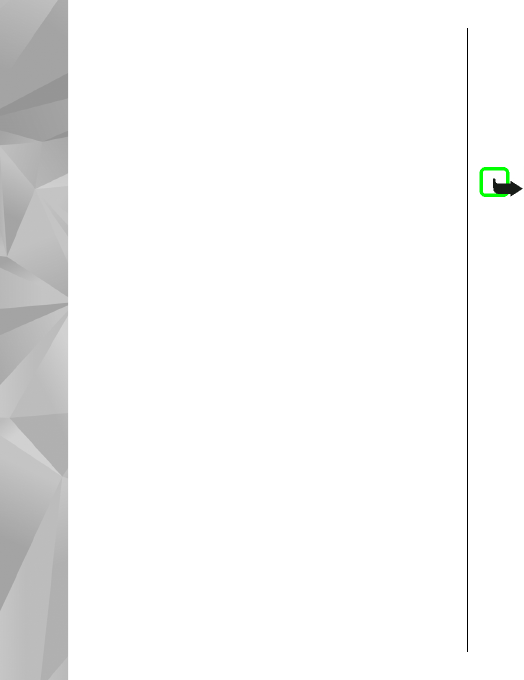
The converter has limited accuracy, and rounding
errors may occur.
1. In the Type field, select the measure you want to
use.
2. In first Unit field, select the unit from which you
want to convert.
3. In the next Unit field, select the unit to which you
want to convert.
4. In the first Amount field, enter the value you
want to convert. The other Amount field changes
automatically to show the converted value.
Convert currency
Select Type > Currency. Before you can make
currency conversions, you must select a base
currency and add exchange rates. The default base
currency is Home. The rate of the base currency is
always 1.
1. Select Options > Currency rates.
2. The default name for the currency items is
Foreign. To rename a currency, select
Options > Rename currency.
3. Add the exchange rates for the currencies, and
press Done.
4. In the second Unit field, select the currency to
which you want to convert.
5. In the first Amount field, enter the value you
want to convert. The other Amount field changes
automatically to show the converted value.
To change the base currency, select Options >
Currency rates, a currency and Options > Set as
base currency.
Note: When you change base currency, you
must enter new exchange rates because all
previously set exchange rates are cleared.
130
Office folder
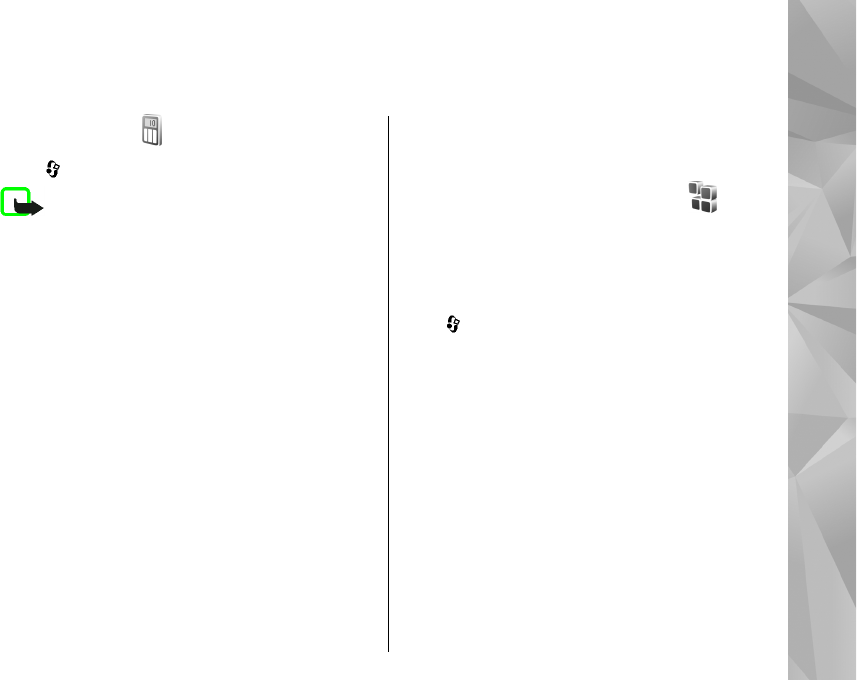
Applications folder
Calculator
Press , and select Applications > Calculator.
Note: This calculator has limited accuracy
and is designed for simple calculations.
To make a calculation, enter the first number of the
calculation. Select a function such as add or subtract
from the function map. Enter the second number of
the calculation, and select =.
The calculator performs operations in the order
they are entered. The result of the calculation
remains in the editor field and can be used as the
first number of a new calculation.
To save the results of a calculation, select Options >
Memory > Save. The saved result replaces the
previously stored result in the memory.
To retrieve the results of a calculation from the
memory and use them in a calculation, select
Options > Memory > Recall.
To view the last saved result, select Options > Last
result. Exiting the Calculator application or
switching off the device does not clear the memory.
You can recall the last saved result the next time you
open the Calculator application.
Application manager
With Application manager, you can see the software
packages installed in your device. You can view
details of installed applications, remove
applications, and define installation settings.
Press , and select Applications > App. mgr..
You can install two types of applications and
software to your device:
●J2ME applications based on Java technology with
the extension .jad or .jar
●Other applications and software suitable for the
Symbian operating system with the
extension .sis or .sisx
Only install software specifically designed for your
device: Nokia N78.
Install applications and software
Installation files may be transferred to your device
from a compatible computer, downloaded during
131
Applications folder
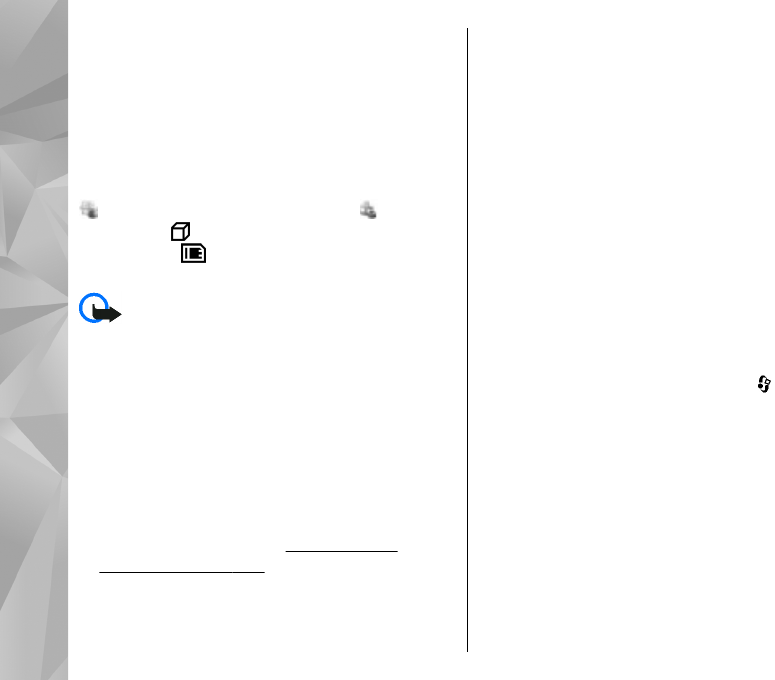
browsing, or sent to you in a multimedia message
as an e-mail attachment or using other connectivity
methods, such as Bluetooth connectivity. You can
use Nokia Application Installer in Nokia Nseries PC
Suite to install an application to your device. If you
use Microsoft Windows Explorer to transfer a file,
save the file to a compatible memory card (local
disk).
indicates a .sis or .sisx application, a Java
application, that the application is not fully
installed, and that the application is installed on
the memory card.
Important: Only install and use applications
and other software from trusted sources, such as
applications that are Symbian Signed or have
passed the Java Verified
TM
testing.
Before installation, note the following:
●To view the application type, version number,
and the supplier or manufacturer of the
application, select Options > View details.
To display the security certificate details of the
application, in Details:, scroll to Certificates:,
and select View details. See "Certificate
management", p. 140.
●If you install a file that contains an update or
repair to an existing application, you can only
restore the original application if you have the
original installation file or a full backup copy of
the removed software package. To restore the
original application, remove the application, and
install the application again from the original
installation file or the backup copy.
The .jar file is required for installing Java
applications. If it is missing, the device may ask
you to download it. If there is no access point
defined for the application, you are asked to
select one. When you are downloading the .jar
file, you may need to enter a user name and
password to access the server. You obtain these
from the supplier or manufacturer of the
application.
To install an application or software, do the
following:
1. To locate an installation file, press , and select
Applications > App. mgr.. Alternatively,
search the device memory or a compatible
memory card (if inserted) in File manager, or
open a message in Messaging > Inbox that
contains an installation file.
2. In Application manager, select Options >
Install. In other applications, scroll to the
installation file, and select it to start the
installation.
During installation, the device shows
information about the progress of the
installation. If you install an application without
132
Applications folder
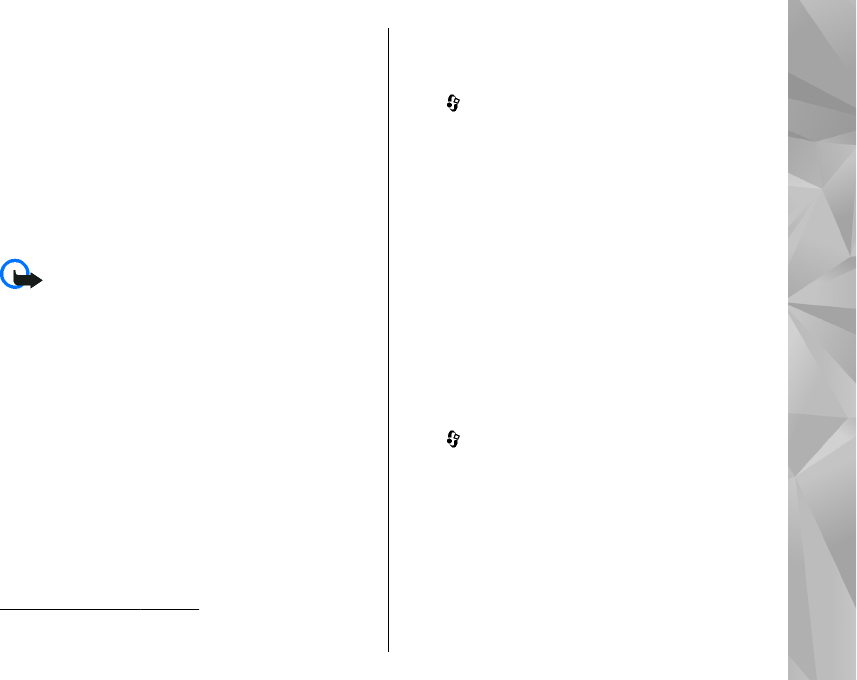
a digital signature or certification, the device
displays a warning. Continue installation only if
you are sure of the origin and contents of the
application.
To start an installed application, locate it in the
menu, and select it. If the application does not have
a default folder defined, it is installed in the
Applications folder in the main menu.
To see which software packages are installed or
removed and when, select Options > View log.
Important: Your device can only support one
antivirus application. Having more than one
application with antivirus functionality could affect
performance and operation or cause the device to
stop functioning.
After you install applications to a compatible
memory card, installation files (.sis) remain in the
device memory. The files may use large amounts of
memory and prevent you from storing other files.
To maintain sufficient memory, use Nokia PC Suite
to back up installation files to a compatible PC, then
use the file manager to remove the installation files
from the device memory. If the .sis file is a message
attachment, delete the message from the
Messaging inbox.
See "File manager", p. 135.
Remove applications and
software
Press , and select Applications > App. mgr..
Scroll to a software package, and select Options >
Remove. Select Yes to confirm.
If you remove software, you can only reinstall it if
you have the original software package or a full
backup of the removed software package. If you
remove a software package, you may no longer be
able to open documents created with that software.
If another software package depends on the
software package that you removed, the other
software package may stop working. Refer to the
documentation of the installed software package
for details.
Settings
Press , and select Applications > App. mgr..
Select Options > Settings and from the following:
●Software installation — Select whether
Symbian software that has no verified digital
signature can be installed.
●Online certificate check — Select to check the
online certificates before installing an
application.
●Default web address — Set the default address
used when checking online certificates.
133
Applications folder

Some Java applications may require that a message
be sent or a network connection be made to a
specific access point to download extra data or
components. In the Application manager main
view, scroll to an application, and select Options >
Open to change settings related to that specific
application.
134
Applications folder
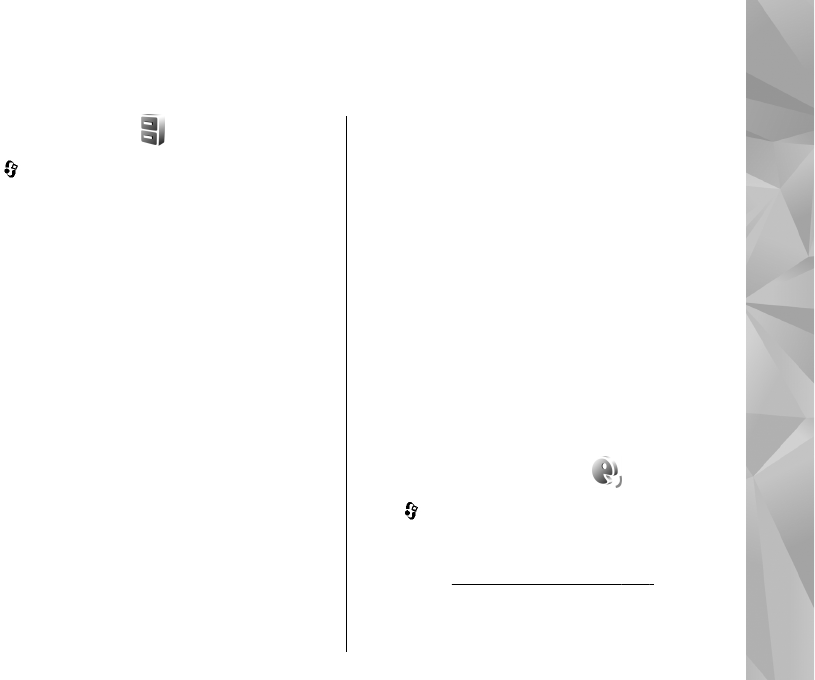
Tools folder
File manager
Press , and select Tools > File mgr..
With File manager, you can browse, manage, and
open files on your device, memory card, or a
compatible external drive.
File manager main view
The available options depend on the memory you
highlight. Select Options and from the following:
●Remove memory card — Remove the memory
card safely from the device without any loss of
data.
●Back up phone memory — Create a backup of
the device memory to a memory card.
●Restore from mem. card — Restore a backup
of the device memory saved on a compatible
memory card. This option is only available if you
have created a backup of the device memory.
●Remote drives — Define settings for a
compatible remote drive connected to your
device, or map or delete drives.
●Find — Find a file in the memory. Enter a search
text that matches the file name.
Phone memory and memory card views
The available options depend on the memory you
select. Select Options and from the following:
●Send — Send a file using available connection
methods.
●Organise — Move and copy files and folders, or
create new folders in the memory.
●Mark/Unmark — Mark files or folders to delete
multiple items at the same time.
●Rename — Rename a file or a folder.
●Details — View the details of the memory or the
selected item.
●Memory card options — Rename or format a
memory card.
●Memory card password — Password protect a
memory card.
Voice commands
Press , and select Tools > Utilities > Voice
comm..
You can use enhanced voice commands to control
your device. See "Voice dialling", p. 118.
135
Tools folder

To activate enhanced voice commands to start
applications and profiles, press and hold the right
selection key in the standby mode.
To use enhanced voice commands, press and hold
the right selection key in the standby mode, and
speak a voice command. The voice command is the
name of the application or profile displayed in the
list.
To edit the voice commands, in the Voice commands
application, select an item, such as an application
or a profile, and Edit.
To listen to the synthesised voice tag, select
Options > Playback.
To remove a voice command that you added
manually, select Options > Remove voice
command.
Select Options > Settings and from the following:
●Synthesiser — to switch on or off the
synthesiser that plays recognised voice tags and
commands in the selected device language
●Playback volume — to adjust the playback
volume for the voice commands
●Recognition sensitivity — to adjust how easily
the synthesiser recognises speech. If the
sensitivity is set too high, it may not accept
commands because of background noise.
●Command verification — to select whether the
spoken command is accepted manually, by voice,
or automatically
●Remove voice adapts. — to reset voice
recognition learning, for example, when the
main user of the device has changed
Sync
Press , and select Tools > Sync.
Sync enables you to synchronise your notes,
calendar entries, text and multimedia messages,
browser bookmarks, or contacts with various
compatible applications on a compatible computer
or on the internet.
You may receive synchronisation settings in a
special message from your service provider.
A synchronisation profile contains the necessary
settings for synchronisation.
When you open the application, the default or
previously used sync profile is displayed. To modify
the profile, scroll to a sync item and select Mark to
include it in the profile or Unmark to leave it out.
To manage sync profiles, select Options and the
desired option.
To synchronise data, select Options >
Synchronise. To cancel synchronisation before it
finishes, select Cancel.
136
Tools folder

Device manager
Press , and select Tools > Utilities > Device
mgr..
Use Device manager to connect to a server and
receive configuration settings for your device, to
create new server profiles, or to view and manage
existing server profiles.
You may receive server profiles and different
configuration settings from your service providers
and company information management
department. These configuration settings may
include connection and other settings used by
different applications in your device.
Scroll to a server profile, and select Options and
from the following:
●Start configuration — Connect to the server
and receive configuration settings for your
device.
●New server profile — Create a server profile.
To delete a server profile, scroll to it, and press C.
137
Tools folder
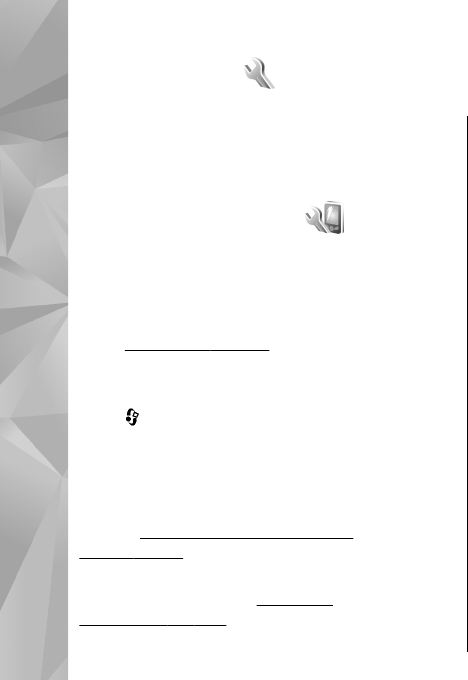
Settings
Some settings may be preset for the device by your
service provider, and you may not be able to change
them.
General settings
In general settings, you can edit the general
settings of your device or restore the device to
original default settings.
You can adjust time and date settings also in the
clock. See "Clock ", p. 125.
Personalisation settings
Press , and select Tools > Settings >
General > Personalisation.
You can edit settings related to the display, standby
mode, and general functions of your device.
Themes allows you to change the look of the
display. See "Change the look of your
device", p. 31.
Voice commands opens the settings for the Voice
commands application. See "Voice
commands", p. 135.
Tones allows you to change the tones of the
calendar, clock, and currently active profile.
Display
●Brightness — Scroll left or right to adjust the
brightness of the display.
●Font size — Adjust the size of the text and icons
on the display.
●Power saver time-out — Select the time-out
period after which the power saver is activated.
●Welcome note / logo — The welcome note or
logo is displayed briefly each time you switch on
the device. Select Default to use the default
image, Text to write a welcome note, or Image
to select an image from Photos.
●Light time-out — Select a time-out after which
the backlight of the display is switched off.
Standby mode
●Shortcuts — Assign shortcuts to the selection
keys to be used in the standby mode and select
which applications are shown in the active
toolbar.
If the active standby is set off, you can assign
keypad shortcuts for the different presses of the
scroll key.
138
Settings

●Change Menu view — Select Horizontal icon
bar to view a horizontal toolbar and the content
from different applications on the screen. Select
Vertical icon bar to view a vertical toolbar on
the screen. The content from different
applications is hidden. To display the content,
select a shortcut and press the scroll key left.
Select Basic to switch off active toolbar.
●Operator logo — This setting is only available
if you have received and saved an operator logo.
Select Off if you do not want the logo to be
shown.
Language
Changing the settings for the phone language or
writing language affects every application in your
device until you change these settings again.
●Phone language — Change the language of the
display text in your device. This also affects the
format used for date and time and the separators
used, for example, in calculations. Automatic
selects the language according to the
information on your SIM card. After you change
the display text language, the device restarts.
●Writing language — Change the writing
language. This affects the characters available
when writing text and the predictive text
dictionary used.
●Predictive text — Set predictive text input on
or off for all editors in the device. The predictive
text dictionary is not available for all languages.
●Default input — Set Pinyin, Stroke, initials,
uppercase, or lowercase.
Enhancement settings
Press , and select Tools > Settings >
General > Enhancement.
Some enhancement connectors indicate which type
of enhancement is connected to the device. See
"Display indicators", p. 24.
The available settings depend on the type of
enhancement. Select an enhancement and from the
following:
●Default profile — Set the profile that you want
activated each time you connect a certain
compatible enhancement to your device.
●Automatic answer — Select whether you want
the device to answer an incoming call
automatically after 5 seconds. If the ringing type
is set to Beep once or Silent, automatic answer
is disabled.
●Lights — Set whether lights remain on or are
switched off after the time-out. This setting is not
available for all enhancements.
139
Settings

Security settings
Phone and SIM
Press , and select Tools > Settings >
General > Security > Phone and SIM card.
●PIN code request — When active, the code is
requested each time the device is switched on.
Deactivating the PIN code request may not be
allowed by some SIM cards.
●PIN code, PIN2 code, and Lock code — You can
change the lock code, PIN code, and PIN2 code.
These codes can only include the numbers from
0 to 9.
If you forget the PIN or the PIN2 code, contact
your service provider. If you forget the lock code,
contact a Nokia Care point or your service
provider.See "Access codes", p. 19.
Avoid using access codes similar to the
emergency numbers to prevent accidental
dialling of the emergency number.
●Keypad autolock period — Select whether the
keypad is locked when your device has been idle
for a certain period of time.
Tip: To lock or unlock the keypad manually,
press the left selection key, then *.
●Phone autolock period — To avoid
unauthorised use, you can set a time-out after
which the device automatically locks. A locked
device cannot be used until the correct lock code
is entered. To turn off the autolock period, select
None.
Tip: To lock the device manually, press the
power key. A list of commands opens.
Select Lock phone.
●Lock if SIM card changed — You can set the
device to ask for the lock code when an unknown
SIM card is inserted into your device. The device
maintains a list of SIM cards that are recognised
as the owner’s cards.
●Closed user group — You can specify a group of
people to whom you can call and who can call
you (network service).
●Confirm SIM services — You can set the device
to display confirmation messages when you are
using a SIM card service (network service).
Certificate management
Press , and select Tools > Settings >
General > Security > Certificate management.
Digital certificates do not guarantee safety; they are
used to verify the origin of software.
In the certificate management main view, you can
see a list of authority certificates that are stored in
your device. Scroll right to see a list of personal
certificates, if available.
Digital certificates should be used if you want to
connect to an online bank or another site or remote
server for actions that involve transferring
140
Settings

confidential information. They should also be used
if you want to reduce the risk of viruses or other
malicious software and be sure of the authenticity
of software when downloading and installing
software.
Important: Even if the use of certificates
makes the risks involved in remote connections and
software installation considerably smaller, they
must be used correctly in order to benefit from
increased security. The existence of a certificate
does not offer any protection by itself; the
certificate manager must contain correct,
authentic, or trusted certificates for increased
security to be available. Certificates have a
restricted lifetime. If "Expired certificate" or
"Certificate not valid yet" is shown even if the
certificate should be valid, check that the current
date and time in your device are correct.
Before changing any certificate settings, you must
make sure that you really trust the owner of the
certificate and that the certificate really belongs to
the listed owner.
View certificate details—check authenticity
You can only be sure of the correct identity of a
server when the signature and the period of validity
of a server certificate have been checked.
You are notified if the identity of the server is not
authentic or if you do not have the correct security
certificate in your device.
To check certificate details, scroll to a certificate,
and select Options > Certificate details. When
you open certificate details, the validity of the
certificate is checked, and one of the following
notes may be displayed:
●Certificate not trusted — You have not set any
application to use the certificate.
●Expired certificate — The period of validity has
ended for the selected certificate.
●Certificate not valid yet — The period of validity
has not yet begun for the selected certificate.
●Certificate corrupted — The certificate cannot
be used. Contact the certificate issuer.
Change the trust settings
Before changing any certificate settings, you must
make sure that you really trust the owner of the
certificate and that the certificate really belongs to
the listed owner.
Scroll to an authority certificate, and select
Options > Trust settings. Depending on the
certificate, a list of the applications that can use the
selected certificate is shown. For example:
●Symbian installation: Yes — The certificate is
able to certify the origin of a new Symbian
operating system application.
141
Settings

●Internet: Yes — The certificate is able to certify
servers.
●App. installation: Yes — The certificate is able
to certify the origin of a new Java™ application.
Select Options > Edit trust setting to change the
value.
Security module
Press , and select Tools > Settings >
General > Security > Security module.
To view or edit a s ecurity module (if available), scroll
to it, and press the scroll key.
To view detailed information about a security
module, scroll to it, and select Options > Security
details.
Restore original settings
Press , and select Tools > Settings >
General > Factory settings.
You can reset some of the settings to their original
values. To do this, you need the lock code.
After resetting, the device may take a longer time
to power on.
Navi wheel settings
Press , and select Tools > Settings >
General > Sensor settings.
Navi wheel
When the Navi wheel setting is set on, you can
browse through files and lists in certain
applications by sliding your finger on the rim of the
scroll key. See "Navi wheel", p. 26. When the Navi
wheel setting is set off, to move up, down, left, or
right, press the scroll key in the desired direction.
Breathing
The rim around the Navi wheel illuminates slowly
when the device is in sleep mode and quickly when
there are missed calls or received messages. To
switch off the illumination, go to Tools >
Settings > General > Sensor settingsselect {No
display_text mapping for
'qtn_sensor_active_status_off.gssensorsettings'
, locale='en'}.
Positioning settings
Press , and select Tools > Settings >
General > Positioning.
Positioning methods
●Integrated GPS — Use the integrated GPS
receiver of your device.
●Assisted GPS — Use Assisted GPS (A-GPS) to
receive assistance data from an assistance data
server. See "Assisted GPS (A-GPS)", p. 35.
●Bluetooth GPS — Use a compatible external GPS
receiver with Bluetooth connectivity.
142
Settings

●Network based — Use information from the
cellular network (network service).
Positioning server
To define an access point, and positioning server for
A-GPS, select Positioning server. The positioning
server may be preset by your service provider, and
you may not be able to edit the settings.
Notation settings
To select which measurement system you want to
use for speeds and distances, select Measurement
system > Metric or Imperial.
To define in which format the coordinate
information is shown in your device, select
Coordinate format, and the desired format.
Phone settings
In phone settings, you can edit settings related to
phone calls and network.
Call settings
Press , and select Tools > Settings > Phone >
Call.
●Send my caller ID — You can set your phone
number to be displayed to (Yes) or hidden from
(No) the person to whom you are calling, or the
value may be set by your service provider when
you make a subscription (Set by network)
(network service).
●Send my internet call ID — You can set your
internet caller ID to be displayed to or hidden
from the person to whom you are calling.
●Call waiting — To be alerted for incoming calls
(network service) while you are in a call, select
Activate. To check whether the function is
activated, select Check status.
●Reject call with message — To send a text
message to a caller informing why you could not
answer the call, select Yes.
●Message text — Write a text to be sent in a text
message when you reject a call.
●Automatic redial — Select On, and your device
makes a maximum of 10 attempts to connect the
call after an unsuccessful call attempt. To stop
automatic redialling, press the end key.
●Show call duration — Activate this setting if
you want the length of a call to be displayed
during the call.
●Summary after call — Activate this setting if
you want the length of a call to be displayed after
the call.
●Speed dial — Select On, and the numbers
assigned to the number keys (2 to 9) can be
dialled by pressing and holding the key. See
"Speed dial a phone number", p. 118.
143
Settings
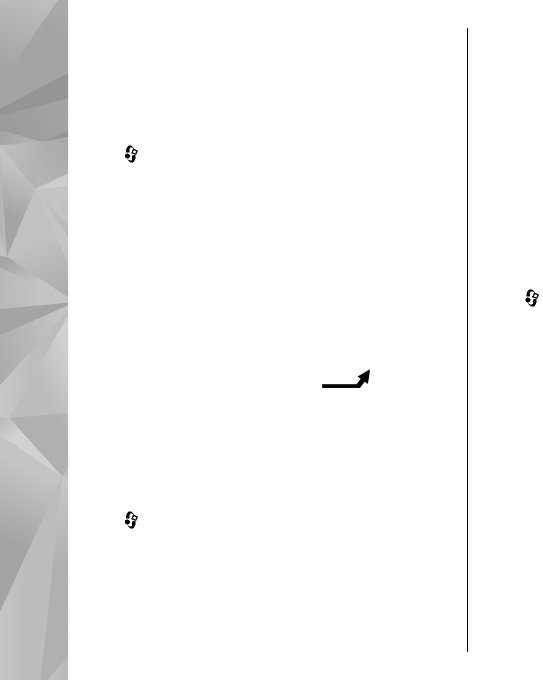
●Anykey answer — Select On, and you can
answer an incoming call by briefly pressing any
keypad key, except the power key.
Call divert
Press , and select Tools > Settings > Phone >
Call divert.
Call divert allows you to divert your incoming calls
to your voice mailbox or another phone number. For
details, contact your service provider.
Select which calls you want to divert and the desired
diverting option. Set the option on (Activate) or off
(Deactivate), or check whether the option is
activated (Check status).
Several diverting options can be active at the same
time. When all calls are diverted, is shown in
the standby mode.
Call barring and call diverting cannot be active at
the same time.
Call barring
Press , and select Tools > Settings > Phone >
Call barring.
Call barring (network service) allows you to restrict
the calls that you make or receive with the device.
To change the settings, you need the barring
password from your service provider.
Call barring and call diverting cannot be active at
the same time.
When calls are barred, calls may be possible to
certain official emergency numbers.
Voice call barring
Select the desired barring option, and set it on
(Activate) or off (Deactivate), or check whether the
option is active (Check status). Call barring affects
all calls, including data calls.
Network settings
Press , and select Tools > Settings > Phone >
Network.
●Operator selection — Select Automatic to set
the device to search for and select one of the
available networks, or Manual to manually
select the network from a list. If the connection
to the manually selected network is lost, the
device sounds an error tone and asks you to
reselect a network. The selected network must
have a roaming agreement with your home
cellular network.
A roaming agreement is an agreement between
two or more service providers to enable the users
of one service provider to use the services of
other service providers.
●Cell info display — Select On to set the device
to indicate when it is used in a cellular network
144
Settings
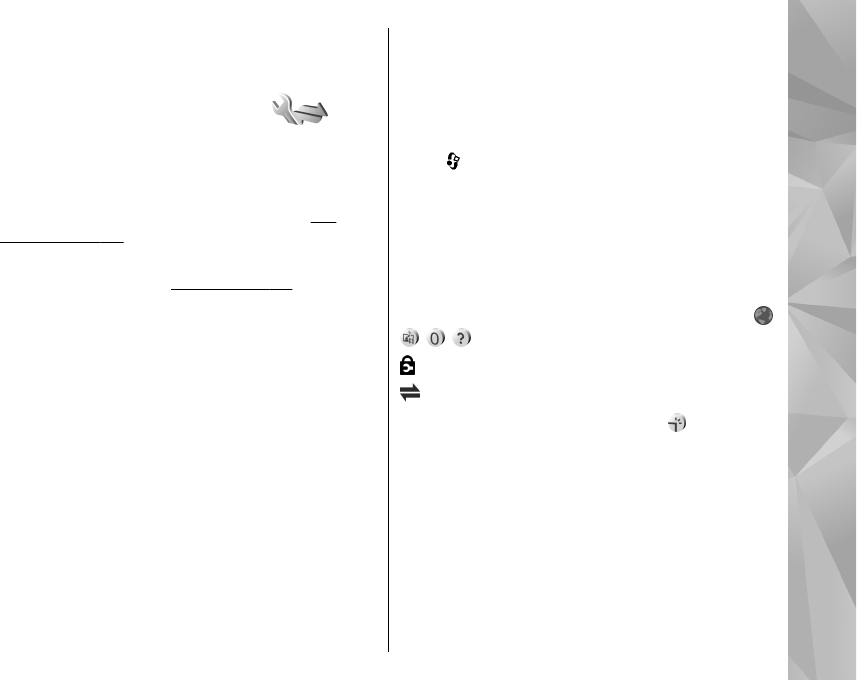
based on microcellular network (MCN)
technology and to activate cell info reception.
Connection settings
In connection settings, you can edit access points
and other connectivity settings.
You can also edit settings for Bluetooth connectivity
in the Bluetooth connectivity application. See
"Settings", p. 91.
You can also edit settings for data cable connections
in the USB application. See "USB", p. 94.
Data connections and access
points
Your device supports packet data connections
(network service), such as GPRS in the GSM network.
To establish a data connection, an access point is
required. You can define different kinds of access
points, such as the following:
●MMS access point to send and receive multimedia
messages
●Internet access point (IAP) to send and receive e-
mail and connect to the internet
Check the type of access point you need with your
service provider for the service you want to access.
For availability and subscription to packet data
connection services, contact your service provider.
Access points
Create a new access point
Press , and select Tools > Settings >
Connection > Destinations.
You may receive access point settings in a message
from a service provider. Some or all access points
may be preset for your device by your service
provider, and you may not be able to change, create,
edit, or remove them.
When you open one of the access point groups ( ,
, , ), you can see the access point types:
indicates a protected access point.
indicates a packet data access point.
To create a new access point, select New access
point. The device asks to check for available
connections. After the search, connections that are
already available are shown and can be shared by a
new access point. If you skip this step, you are asked
to select a connection method and to define the
settings needed.
To edit the settings of an access point, open one of
the access point groups, select an access point and
Edit. Follow the instructions from your service
provider.
145
Settings

●Connection name — Enter a descriptive name
for the connection.
●Data bearer — Select the data connection type.
Depending on the data connection you select, only
certain setting fields are available. Fill in all fields
marked with Must be defined or with a red *. Other
fields can be left empty, unless your service provider
has instructed otherwise.
To use a data connection, your service provider
must support this feature, and if necessary, activate
it for your SIM card.
Packet data access points
Press , and select Tools > Settings >
Connection > Destinations > New access
point, and follow the instructions on the screen. Or,
open one of the access point groups, select an
access point marked with , and select Edit.
Follow the instructions from your service provider.
●Access point name — You obtain the access
point name from your service provider.
●User name — The user name may be needed to
make a data connection, and is usually provided
by the service provider.
●Prompt password — If you must enter the
password every time you log in to a server, or if
you do not want to save your password in the
device, select Yes.
●Password — A password may be needed to
make a data connection and is usually provided
by the service provider.
●Authentication — Select Secure to always send
your password encrypted or Normal to send
your password encrypted when possible.
●Homepage — Depending on the access point
you are setting up, enter the web address or the
address of the multimedia messaging centre.
Select Options > Advanced settings to change
the following settings:
●Network type — Select the internet protocol
type to transfer data to and from your device. The
other settings depend on the selected network
type.
●Phone IP address (for IPV4 only) — Enter the IP
address of your device.
●DNS addresses — Enter the IP addresses of the
primary and secondary DNS servers, if required
by your service provider. Contact your internet
service provider to obtain these addresses.
●Proxy server address — Enter the address of
the proxy server.
●Proxy port number — Enter the port number
of the proxy server.
Packet data settings
Press , and select Tools > Settings >
Connection > Packet data.
146
Settings
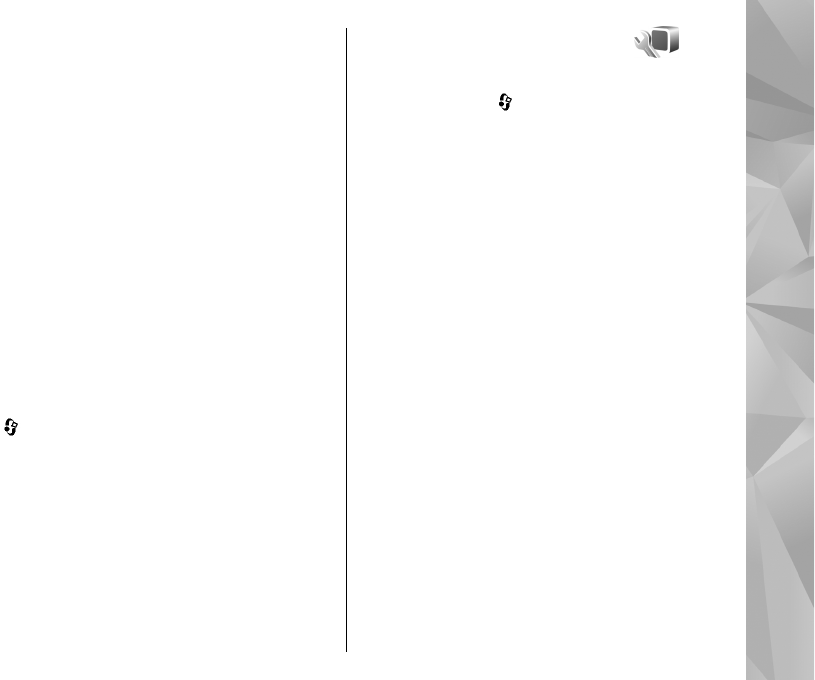
The packet data settings affect all access points
using a packet data connection.
●Packet data connection — If you select When
available and you are in a network that supports
packet data, the device registers to the packet
data network. Starting an active packet data
connection (for example, to send and receive e-
mail) is quicker. If there is no packet data
coverage, the device periodically tries to
establish a packet data connection. If you select
When needed, the device uses a packet data
connection only if you start an application or
action that needs it.
●Access point — The access point name is needed
to use your device as a packet data modem to a
compatible computer.
Configurations
Press , and select Tools > Settings >
Connection > Configurations.
You may receive trusted server settings from your
service provider in a configuration message. You
can save view or delete these settings in
configurations.
Application settings
To edit the settings of some of the applications in
your device, press , and select Tools >
Settings > Applications.
To edit the settings, you can also select Options >
Settings in each application.
147
Settings

Troubleshooting
Q: What is my password for the lock, PIN, or
PUK codes?
A: The default lock code is 12345. If you forget or
lose the lock code, contact your device dealer. If you
forget or lose a PIN or PUK code, or if you have not
received such a code, contact your network service
provider. For information about passwords, contact
your access point provider, for example, a
commercial internet service provider (ISP) or
network service provider.
Q: How do I close an application that is not
responding?
A: Press and hold . To close an application, scroll
to it, and press C . Pressing C does not close Music
player. To close Music player, select it from the list,
and Options > Exit.
Q: Why do images look smudgy?
A: Ensure that the camera lens protection windows
are clean.
Q: Why do missing, discoloured, or bright
dots appear on the screen every time I turn
on my device?
A: This is a characteristic of this type of display.
Some displays may contain pixels or dots that
remain on or off. This is normal, not a fault.
Q: Why can't my device establish a GPS
connection?
A: Find more information about GPS, GPS receiver,
satellite signals, and location information in this
user guide. See "Positioning (GPS)", p. 35.
Q: Why can’t I find my friend’s device while
using Bluetooth connectivity?
A: Check that both devices are compatible, have
activated Bluetooth connectivity, and are not in
hidden mode. Check also that the distance between
the two devices is not over 10 metres (33 feet) and
that there are no walls or other obstructions
between the devices.
Q: Why can’t I end a Bluetooth connection?
A: If another device is connected to your device, you
can either end the connection using the other
device or by deactivating Bluetooth connectivity.
148
Troubleshooting

Press , and select Tools > Bluetooth >
Bluetooth > Off.
Q: How can I save my data before deleting it?
A: To save data, use Nokia Nseries PC Suite to make
a back-up copy of all data to a compatible computer;
send images to your e-mail address, then save the
images to your computer; or send data using
Bluetooth connectivity to a compatible device. You
can also store data on a compatible memory card.
Q: Why can’t I select a contact for my
message?
A: The contact card does not have a phone number,
an address, or an e-mail address. Press , select
Contacts, and edit the contact card.
Q: How can I end the data connection when
the device starts a data connection again and
again?
A: The device may be trying to retrieve a multimedia
message from the multimedia message centre. To
stop the device from making a data connection,
press , and select Messaging > Options >
Settings > Multimedia message > Multimedia
retrieval and Manual to have the multimedia
messaging centre save messages to be retrieved
later, or Off to ignore all incoming multimedia
messages. If you select Manual, you receive a
notification when there is a new multimedia
message that you can retrieve in the multimedia
message centre. If you select Off, the device does
not make any network connections related to
multimedia messaging. To set the device to use a
packet data connection only if you start an
application or action that needs it, press , and
select Tools > Settings > Connection > Packet
data > Packet data connection > When
needed. If this does not help, switch the device off,
and switch it on again.
Q: Why do I have problems connecting the
device to my PC?
A: Ensure that you have the latest version of Nokia
Nseries PC Suite and that it is installed and running
on your compatible PC. For further information on
how to use Nokia Nseries PC Suite, see the help
function on Nokia Nseries PC Suite or visit the Nokia
support pages.
Q: Can I use my device as a fax modem with
a compatible PC?
A: You cannot use your device as a fax modem.
However, with call diverting (network service), you
can divert incoming fax calls to another phone
number.
149
Troubleshooting
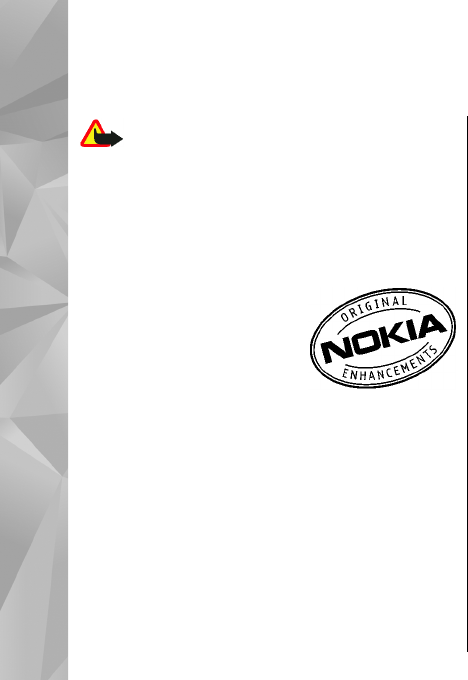
Nokia original enhancements
Warning: Use only batteries, chargers, and
enhancements approved by Nokia for use with this
particular model. The use of any other types may
invalidate any approval or warranty, and may be
dangerous.
For availability of approved enhancements, please
check with your dealer.
An extensive range of
enhancements is available for
your device. Please visit
www.nokia.com.cn for more
details.
Text.
Title:
1. Text.
Text.
Text.
2. Text: www.shop.nokia.com.cn.
Enhancements
Practical rules about accessories and enhancements
●Keep all accessories and enhancements out of the
reach of small children.
●When you disconnect the power cord of any
accessory or enhancement, grasp and pull the
plug, not the cord.
●Check regularly that enhancements installed in a
vehicle are mounted and are operating properly.
●Installation of any complex car enhancements
must be made by qualified personnel only.
Title?
Text.
Title
●Text.
●Text.
●Text.
●Text.
Title
●Text.
●Text.
●Text.
150
Nokia original enhancements
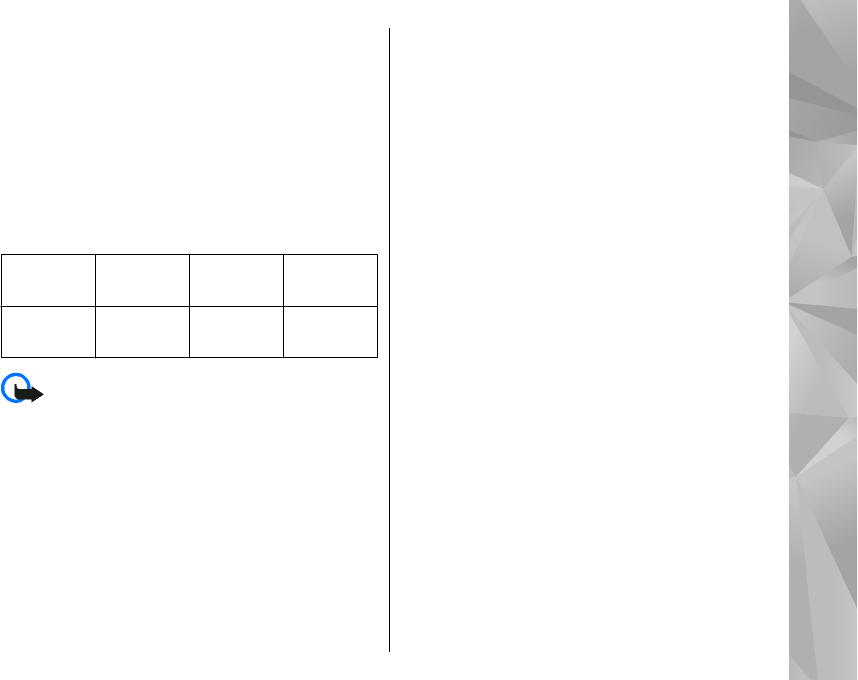
Bolded text: Text.
Bolded text: Text.
Bolded text: Text.
Bolded text: Text.
Bolded text: Text.
Bolded text: Text.
Battery
Battery
model
Type Talk time Standby
time
BL-6F Li-Ion Up to XX
minutes
Up to XX
hours
Important: These battery talk and standby
times can only be reached in certain optimised
network conditions or surroundings. The actual
battery talk and standby times may differ
depending on SIM card, features used, battery age
and condition, temperatures to which battery is
exposed, different network conditions, and many
other factors, so that the talk and standby times
may be significantly shorter than given here. In
addition, ringing tones, handsfree, use in digital
mode, and other functions consume the power, and
the amount of time a device is used for calls will
affect its standby time. Likewise, the amount of
time that the device is turned on and in the standby
mode will affect its talk time.
151
Nokia original enhancements

Battery information
Charging and discharging
Your device is powered by a rechargeable battery.
The battery can be charged and discharged
hundreds of times, but it will eventually wear out.
When the talk and standby times are noticeably
shorter than normal, replace the battery. Use only
Nokia approved batteries, and recharge your
battery only with Nokia approved chargers
designated for this device.
If a replacement battery is being used for the first
time or if the battery has not been used for a
prolonged period, it may be necessary to connect
the charger, then disconnect and reconnect it to
begin charging the battery.
Unplug the charger from the electrical plug and the
device when not in use. Do not leave a fully charged
battery connected to a charger, since overcharging
may shorten its lifetime. If left unused, a fully
charged battery will lose its charge over time.
If the battery is completely discharged, it may take
several minutes before the charging indicator
appears on the display or before any calls can be
made.
Use the battery only for its intended purpose. Never
use any charger or battery that is damaged.
Do not short-circuit the battery. Accidental short-
circuiting can occur when a metallic object such as
a coin, clip, or pen causes direct connection of the
positive (+) and negative (-) terminals of the
battery. (These look like metal strips on the
battery.) This might happen, for example, when you
carry a spare battery in your pocket or purse. Short-
circuiting the terminals may damage the battery or
the connecting object.
Leaving the battery in hot or cold places, such as in
a closed car in summer or winter conditions, will
reduce the capacity and lifetime of the battery.
Always try to keep the battery between 15°C and
25°C (59°F and 77°F). A device with a hot or cold
battery may not work temporarily, even when the
battery is fully charged. Battery performance is
particularly limited in temperatures well below
freezing.
Do not dispose of batteries in a fire as they may
explode. Batteries may also explode if damaged.
Dispose of batteries according to local regulations.
Please recycle when possible. Do not dispose as
household waste.
152
Battery information
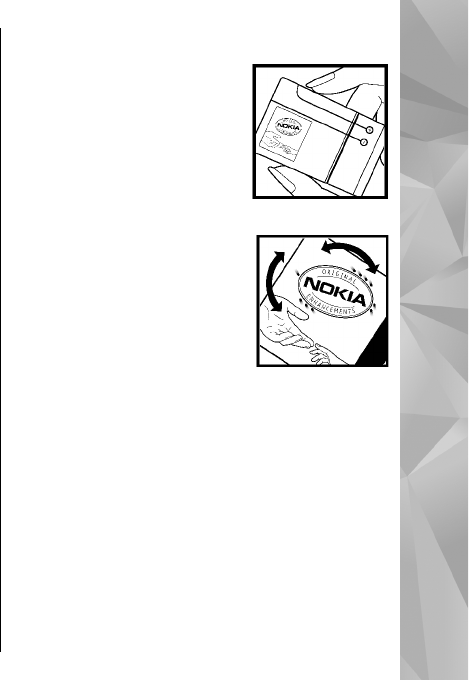
Do not dismantle or shred cells or batteries. In the
event of a battery leak, do not allow the liquid to
come in contact with the skin or eyes. In the event
of such a leak, flush your skin or eyes immediately
with water, or seek medical help.
Nokia battery
authentication guidelines
Always use original Nokia batteries for your safety.
To check that you are getting an original Nokia
battery, purchase it from an authorised Nokia
dealer, and inspect the hologram label using the
following steps:
Successful completion of the steps is not a total
assurance of the authenticity of the battery. If you
have any reason to believe that your battery is not
an authentic, original Nokia battery, you should
refrain from using it, and take it to the nearest
authorised Nokia service point or dealer for
assistance. Your authorised Nokia service point or
dealer will inspect the battery for authenticity. If
authenticity cannot be verified, return the battery
to the place of purchase.
Authenticate hologram
1. When you look at the
hologram on the label, you
should see the Nokia
connecting hands symbol
from one angle and the
Nokia Original
Enhancements logo when
looking from another angle.
2. When you angle the
hologram left, right, down
and up, you should see 1, 2,
3 and 4 dots on each side
respectively.
What if your battery is not
authentic?
If you cannot confirm that your Nokia battery with
the hologram on the label is an authentic Nokia
battery, please do not use the battery. Take it to the
nearest authorised Nokia service point or dealer for
assistance. The use of a battery that is not approved
by the manufacturer may be dangerous and may
result in poor performance and damage to your
device and its enhancements. It may also invalidate
any approval or warranty applying to the device.
153
Battery information

To find out more about original Nokia batteries,
visit .
154
Battery information

Care and maintenance
Your device is a product of superior design and
craftsmanship and should be treated with care. The
following suggestions will help you protect your
warranty coverage.
●Keep the device dry. Precipitation, humidity, and
all types of liquids or moisture can contain
minerals that will corrode electronic circuits. If
your device does get wet, remove the battery,
and allow the device to dry completely before
replacing it.
●Do not use or store the device in dusty, dirty
areas. Its moving parts and electronic
components can be damaged.
●Do not store the device in hot areas. High
temperatures can shorten the life of electronic
devices, damage batteries, and warp or melt
certain plastics.
●Do not store the device in cold areas. When the
device returns to its normal temperature,
moisture can form inside the device and damage
electronic circuit boards.
●Do not attempt to open the device other than as
instructed in this guide.
●Do not drop, knock, or shake the device. Rough
handling can break internal circuit boards and
fine mechanics.
●Do not use harsh chemicals, cleaning solvents, or
strong detergents to clean the device.
●Do not paint the device. Paint can clog the
moving parts and prevent proper operation.
●Use a soft, clean, dry cloth to clean any lenses,
such as camera, proximity sensor, and light
sensor lenses.
●Use only the supplied or an approved
replacement antenna. Unauthorized antennas,
modifications, or attachments could damage the
device and may violate regulations governing
radio devices.
●Use chargers indoors.
●Always create a backup of data you want to keep,
such as contacts and calendar notes.
●To reset the device from time to time for
optimum performance, power off the device and
remove the battery.
These suggestions apply equally to your device,
battery, charger, or any enhancement. If any device
155
Care and maintenance
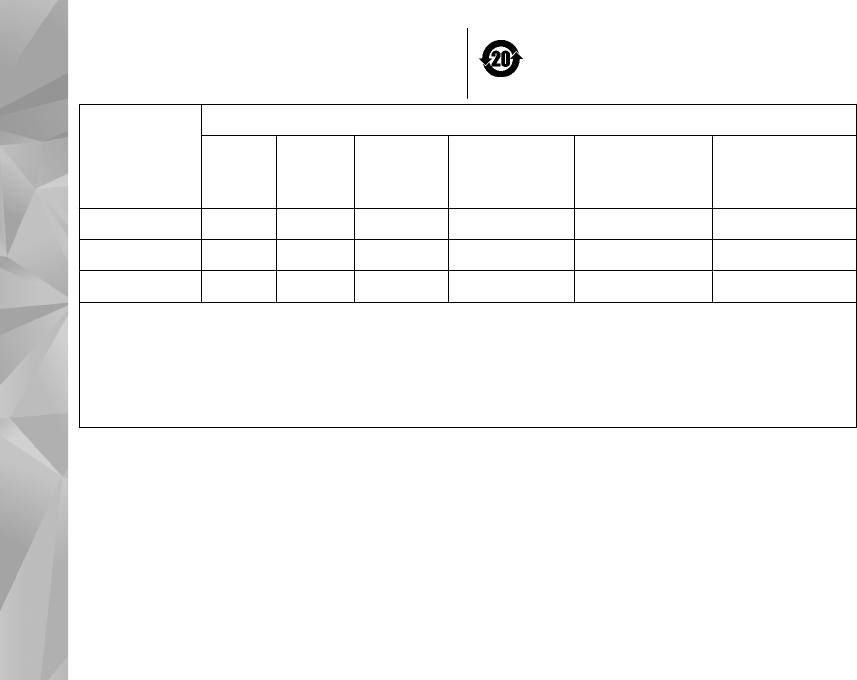
is not working properly, take it to the nearest
authorized service facility for service.
Part name Toxic or hazardous Substances and Elements
Lead (Pb) Mercury
(Hg)
Cadmium
(Cd)
Hexavalent
Chromium (Cr6+)
Polybrominated
biphenys (PBB)
Polybrominated
diphenyl ethers
(PBDE)
Phone x O O O O O
Battery x O O O O O
Accessories x O O O O O
O: Indicates that this toxic or hazardous substance contained in all of the homogeneous materials for this part
is below the limit requirement in SJ/T 11363-2006.
X: Indicates that this toxic or hazardous substance contained in at least one of the homogeneous materials used
for this part is above the limit requirement in SJ/T 11363-2006.
Notes: The reason for marking "X" is: there is currently no alternative technologies available.
156
Care and maintenance

Additional safety information
Small children
Your device and its enhancements may contain
small parts. Keep them out of the reach of small
children.
Operating environment
This device meets RF exposure guidelines when
used either in the normal use position against the
ear or when positioned at least 1.5 centimeters (5/8
inch) away from the body. When a carry case, belt
clip, or holder is used for body-worn operation, it
should not contain metal and should position the
device the above-stated distance from your body.
To transmit data files or messages, this device
requires a quality connection to the network. In
some cases, transmission of data files or messages
may be delayed until such a connection is available.
Ensure the above separation distance instructions
are followed until the transmission is completed.
Parts of the device are magnetic. Metallic materials
may be attracted to the device. Do not place credit
cards or other magnetic storage media near the
device, because information stored on them may be
erased.
Medical devices
Operation of any radio transmitting equipment,
including wireless phones, may interfere with the
functionality of inadequately protected medical
devices. Consult a physician or the manufacturer of
the medical device to determine if they are
adequately shielded from external RF energy or if
you have any questions. Switch off your device in
health care facilities when any regulations posted
in these areas instruct you to do so. Hospitals or
health care facilities may be using equipment that
could be sensitive to external RF energy.
Implanted medical devices
Manufacturers of medical devices recommend that
a minimum separation of 15.3 centimeters (6
inches) should be maintained between a wireless
device and an implanted medical device, such as a
pacemaker or implanted cardioverter defibrillator,
to avoid potential interference with the medical
device. Persons who have such devices should:
157
Additional safety information

●Always keep the wireless device more than 15.3
centimeters (6 inches) from the medical device
when the wireless device is turned on.
●Not carry the wireless device in a breast pocket.
●Hold the wireless device to the ear opposite the
medical device to minimize the potential for
interference.
●Turn the wireless device off immediately if there
is any reason to suspect that interference is
taking place.
●Read and follow the directions from the
manufacturer of their implanted medical device.
If you have any questions about using your wireless
device with an implanted medical device, consult
your health care provider.
Hearing aids
Some digital wireless devices may interfere with
some hearing aids. If interference occurs, consult
your service provider.
Vehicles
RF signals may affect improperly installed or
inadequately shielded electronic systems in motor
vehicles such as electronic fuel injection systems,
electronic antiskid (antilock) braking systems,
electronic speed control systems, and air bag
systems. For more information, check with the
manufacturer, or its representative, of your vehicle
or any equipment that has been added.
Only qualified personnel should service the device
or install the device in a vehicle. Faulty installation
or service may be dangerous and may invalidate any
warranty that may apply to the device. Check
regularly that all wireless device equipment in your
vehicle is mounted and operating properly. Do not
store or carry flammable liquids, gases, or explosive
materials in the same compartment as the device,
its parts, or enhancements. For vehicles equipped
with an air bag, remember that air bags inflate with
great force. Do not place objects, including installed
or portable wireless equipment in the area over the
air bag or in the air bag deployment area. If in-
vehicle wireless equipment is improperly installed
and the air bag inflates, serious injury could result.
Using your device while flying in aircraft is
prohibited. Switch off your device before boarding
an aircraft. The use of wireless teledevices in an
aircraft may be dangerous to the operation of the
aircraft, disrupt the wireless telephone network,
and may be illegal.
158
Additional safety information

Potentially explosive
environments
Switch off your device when in any area with a
potentially explosive atmosphere, and obey all
signs and instructions. Potentially explosive
atmospheres include areas where you would
normally be advised to turn off your vehicle engine.
Sparks in such areas could cause an explosion or fire
resulting in bodily injury or even death. Switch off
the device at refuelling points such as near gas
pumps at service stations. Observe restrictions on
the use of radio equipment in fuel depots, storage,
and distribution areas; chemical plants; or where
blasting operations are in progress. Areas with a
potentially explosive atmosphere are often, but not
always, clearly marked. They include below deck on
boats, chemical transfer or storage facilities and
areas where the air contains chemicals or particles
such as grain, dust, or metal powders. You should
check with the manufacturers of vehicles using
liquefied petroleum gas (such as propane or
butane) to determine if this device can be safely
used in their vicinity.
Certification information
(SAR)
This mobile device meets guidelines for
exposure to radio waves.
Your mobile device is a radio transmitter and
receiver. It is designed not to exceed the limits for
exposure to radio waves recommended by
international guidelines. These guidelines were
developed by the independent scientific
organization ICNIRP and include safety margins
designed to assure the protection of all persons,
regardless of age and health.
The exposure guidelines for mobile devices employ
a unit of measurement known as the Specific
Absorption Rate or SAR. The SAR limit stated in the
ICNIRP guidelines is 2.0 watts/kilogram (W/kg)
averaged over 10 grams of tissue. Tests for SAR are
conducted using standard operating positions with
the device transmitting at its highest certified
power level in all tested frequency bands. The actual
SAR level of an operating device can be below the
maximum value because the device is designed to
use only the power required to reach the network.
That amount changes depending on a number of
factors such as how close you are to a network base
station. The highest SAR value under the ICNIRP
guidelines for use of the device at the ear is 1.01 W/
kg.
159
Additional safety information

Use of device accessories and enhancements may
result in different SAR values. SAR values may vary
depending on national reporting and testing
requirements and the network band. Additional SAR
information may be provided under product
information at www.nokia.com.
Emergency calls
Important: Wireless phones, including this
device, operate using radio signals, wireless
networks, landline networks, and user-
programmed functions. Because of this,
connections in all conditions cannot be guaranteed.
You should never rely solely on any wireless device
for essential communications like medical
emergencies.
4. Press the call key.
If certain features are in use, you may first need to
turn those features off before you can make an
emergency call. If the device is in the offline or flight
profile mode, you may need to change the profile
to activate the phone function before you can make
an emergency call. Consult this guide or your service
provider for more information.
When making an emergency call, give all the
necessary information as accurately as possible.
Your wireless device may be the only means of
communication at the scene of an accident. Do not
end the call until given permission to do so.
160
Additional safety information
To make an emergency call:
1. If the device is not on, switch it on. Check for
adequate signal strength.
Some networks may require that a valid SIM card
is properly inserted in the device.
2. Press the end key as many times as needed to
clear the display and ready the device for calls.
3. Enter the official emergency number for your
present location. Emergency numbers vary by
location.

MANUFACTURER’S LIMITED WARRANTY
This Limited Warranty is in addition to, and does not
affect your legal (statutory) rights under your
applicable national laws relating to the sale of
consumer products.
Nokia Corporation (“Nokia”) provides this Limited
Warranty to person who has purchased the Nokia
product(s) included in the sales package
(“Product”).
Nokia warrants to you that during the warranty
period Nokia or a Nokia authorized service company
will in a commercially reasonable time remedy
defects in materials, design and workmanship free
of charge by repairing or, should Nokia in its
absolute discretion deem it necessary, replacing the
Product in accordance with this Limited Warranty
(unless otherwise required by law). This Limited
Warranty is only valid and enforceable in the
country where you have purchased the Product
provided that it is intended for sale in that country.
Warranty period
The warranty period starts at the time of Product's
original purchase by the first end-user. The Product
may consist of several different parts and different
parts may be covered by a different warranty period
(hereinafter “Warranty Period”). The different
Warranty Periods are:
a) twelve (12) months for the mobile device and
accessories (whether included in the mobile device
sales package or sold separately) other than the
consumable parts and accessories listed in (b) and
(c) below;
b) six (6) months for the following consumable
parts and accessories: batteries, chargers, desk
stands, headsets, cables and covers; and
c) ninety (90) days for the media on which any
software is provided, for example, CD-ROM or
memory card
As far as your national laws permit, the Warranty
Period will not be extended or renewed or
otherwise affected due to subsequent resale, repair
or replacement of the Product. However, repaired
part(s) will be warranted for the remainder of the
original Warranty Period or for sixty (60) days from
the date of repair, whichever is longer.
161
MANUFACTURER’S LIMITED WARRANTY

How to get warranty service
If you wish to make a claim under the Limited
Warranty, you may call the Nokia call center (where
this is available and please note national rates apply
to calls) and/or where necessary, return your
Product or the affected part (if it is not the entire
Product) to a Nokia care center or Nokia designated
service location. Information about Nokia care
centers, Nokia designated service locations and
Nokia call centers can be found at local Nokia web
pages where available.
You must return your Product or the affected part
(if it is not the entire Product) to a Nokia care center
or Nokia designated service location before the
expiry of the Warranty Period.
When making a Limited Warranty claim you have to
present: a) the Product (or affected part thereto), b)
the legible and unmodified original proof of
purchase, which clearly indicates the name and
address of the seller, the date and place of purchase,
the product type and the IMEI or other serial
number.
This Limited Warranty extends only to the original
first end-user of the Product and is not assignable
or transferable to any subsequent purchaser/end-
user.
What is not covered?
1. This Limited Warranty does not cover user
manuals or any third party software, settings,
content, data or links, whether included/
downloaded in the Product, whether included
during installment, assembly, shipping or at any
other time in the delivery chain or otherwise and in
any way acquired by you. To the extent permitted
by applicable law(s), Nokia does not warrant that
any Nokia software will meet your requirements,
will work in combination with any hardware or
software applications provided by a third party, that
the operation of the software will be uninterrupted
or error free or that any defects in the software are
correctable or will be corrected.
2. This Limited Warranty does not cover a) normal
wear and tear (including, without limitation, wear
and tear of camera lenses, batteries or displays), b)
transport costs, c) defects caused by rough handling
(including, without limitation, defects caused by
sharp items, by bending, compressing or dropping,
etc.), d) defects or damage caused by misuse of the
Product, including use that is contrary to the
instructions provided by Nokia (e.g. as set out in the
Product's user guide) and/or e) other acts beyond
the reasonable control of Nokia.
3. This Limited Warranty does not cover defects or
alleged defects caused by the fact that the Product
162
MANUFACTURER’S LIMITED WARRANTY

was used with, or connected to, a product,
accessories, software and/or service not
manufactured, supplied or authorized by Nokia or
was used otherwise than for its intended use.
Defects can be caused by viruses from your or from
a third party's unauthorised access to services,
other accounts, computer systems or networks. This
unauthorised access can take place through
hacking, password-mining or through a variety of
other means.
4. This Limited Warranty does not cover defects
caused by the fact that the battery has been short-
circuited or by the fact that the seals of the battery
enclosure or the cells are broken or show evidence
of tampering or by the fact that the battery has been
used in equipment other than those for which it has
been specified.
5. This Limited Warranty does not apply if the
Product has been opened, modified or repaired by
anyone other than an authorized service centre, if
it is repaired using unauthorised spare parts or if
the Product’s serial number, the mobile accessory
date code or the IMEI number has been removed,
erased, defaced, altered or are illegible in any way
and this shall be determined in the sole discretion
of Nokia.
6. This Limited Warranty does not apply if the
Product has been exposed to moisture, to
dampness or to extreme thermal or environmental
conditions or to rapid changes in such conditions,
to corrosion, to oxidation, to spillage of food or
liquid or to influence from chemical products.
Other important notices
A third party, independent operator provides the
SIM card and cellular and/or other network or
system on which the Product operates. Therefore,
Nokia will not accept responsibility under this
warranty for the operation, availability, coverage,
services or range of the cellular or other network or
system. Before the Product can be repaired or
replaced, the operator may need to unlock any SIM-
lock or other lock that may have been added to lock
the product to a specific network or operator.
Accordingly, Nokia does not accept responsibility
for any delays in warranty repairs or for the inability
of Nokia to complete warranty repairs that are
caused by the operator's delay or failure to unlock
any SIM-lock or other lock.
Please remember to make backup copies or keep
written records of all important content and data
stored in your Product, because content and data
may be lost during repair or replacement of the
Product. Nokia, in a manner consistent with the
provisions of the section entitled “Limitation of
Nokia's Liability” below, to the extent permitted by
applicable law(s), shall not under any circumstances
163
MANUFACTURER’S LIMITED WARRANTY

be liable, either expressly or implied, for any
damages or losses of any kind whatsoever resulting
from loss of, damage to, or corruption of, content
or data during repair or replacement of the Product.
All parts of the Product or other equipment that
Nokia has replaced shall become the property of
Nokia. If the returned Product is found not to be
covered by the terms and conditions of the Limited
Warranty, Nokia and its authorized service
companies reserve the right to charge a handling
fee. When repairing or replacing the Product, Nokia
may use products or parts that are new, equivalent
to new or reconditioned.
Your Product may contain country specific
elements, including software. If the Product has
been re-exported from its original destination
country to another country, the Product may
contain country specific elements that are not
considered to be a defect under this Limited
Warranty.
Limitation of Nokia's liability
This Limited Warranty is your sole and exclusive
remedy against Nokia and Nokia's sole and
exclusive liability in respect of defects in your
Product. However, this Limited Warranty shall
neither exclude nor limit i) any of your legal
(statutory) rights under the applicable national
laws or ii) any of your rights against the seller of the
Product.
This Limited Warranty replaces all other Nokia
warranties and liabilities, whether oral, written,
(non-mandatory) statutory, contractual, in tort or
otherwise, including, without limitation, and
where permitted by applicable law, any implied
conditions, warranties or other terms as to
satisfactory quality or fitness for purpose. To the
extent permitted by applicable law(s) Nokia does
not assume any liability for loss of or damage to or
corruption of data, for any loss of profit, loss of use
of Products or functionality, loss of business, loss of
contracts, loss of revenues or loss of anticipated
savings, increased costs or expenses or for any
indirect loss or damage, consequential loss or
damage or special loss or damage. To the extent
permitted by applicable law, Nokia’s liability shall
be limited to the purchase value of the Product. The
above limitations shall not apply to death or
personal injury resulting from Nokia’s proven
negligence.
Statutory obligations
This Limited Warranty must be read subject to any
statutory provisions that imply warranties or
conditions into this Limited Warranty that cannot
be excluded, restricted or modified or cannot be
164
MANUFACTURER’S LIMITED WARRANTY

excluded, restricted or modified except to a limited
extent. If such statutory provisions apply, to the
extent to which Nokia is able to do so, its liability
under those provisions will be limited, at its option
to, in the case of goods: the replacement of the
goods or the supply of equivalent goods, the repair
of the goods, the payment of the cost of replacing
the goods or of acquiring equivalent goods, or the
payment of the cost of having the goods repaired;
and in the case of services: the supplying of the
services again or the payment of the cost of having
the services supplied again.
Note: Your Product is a sophisticated
electronic device. Nokia strongly encourages you to
familiarise yourself with the user guide and
instructions provided with and for the Product.
Please also note that the Product might contain
high precision displays, camera lenses and other
such parts, which could be scratched or otherwise
damaged if not handled very carefully.
All warranty information, product features and
specifications are subject to change without notice.
Nokia Corporation
Keilalahdentie 2-4
FIN-02150 Espoo
Finland
165
MANUFACTURER’S LIMITED WARRANTY

How to obtain an English Nokia N78 User
Guide
Nokia understands from consumer feedback in PRC that there is only
limited usage of the English User Guide.
In consideration of this and to help conserve natural resources, Nokia
has selected to not to include the English User Guide in the Nokia
N78 Sales Package.
To obtain a Nokia N78 User Guide in English, please kindly
download it from: www.nokia.com.cn/englishUG.
The feature descriptions in English User Guide may vary by market,
thus the device features described in the English User Guide you
have obtained may differ from those shown on the display in English
user interface.
166
How to obtain an English Nokia N78 User Guide

Index
A
access codes 19
access points 145
accessories
See
enhancements
active standby mode 33,
138
active toolbar 62
in camera 60
in Photos 72
address book
See
contacts
alarm clock 125
alarm, calendar note 126
albums, media 72
anniversary notes 125
answering calls 117
antennas 22
application manager 131
applications 131
assisted GPS (A-GPS) 35
attachments 108, 109
audio messages 106
audio themes 32
auto-update for time/
date 125
B
backing up device
memory 135
backlight time-out 138
battery
power saver setting 138
saving power 19
birthday notes 125
blogs 85
Bluetooth connectivity
blocking devices 94
device address 93
device visibility 92
pairing devices 93
receiving data 93
security 92
sending data 92
settings 91
switching on/off 91
bookmarks 87
browser
bookmarks 87
browsing pages 83, 85
cache memory 87
downloads 86
security 88
settings 88
widgets 86
C
cable connection 94
cache memory 87
calculator 131
calendar 125
call waiting 118
calls 116
answering 117
conference 117
duration of 119
log for 120
options during 116
recording 98
rejecting 117
settings 143
camera
colour 68
flash 62
geotagging 62
image quality 67
imaging mode 61
indicators 59
lighting 68
location information 62
167
Index

options 62
scenes 63
self-timer 64
sequence mode 63
settings 67
video mode 66
video quality 69
cell broadcast messages 105
certificates 140
charts, spreadsheet 128
clock 34, 125
computer connections 95
See also
data connections
conference calls 117
configuration
See
settings
contact information 18
contacts
copying 122
default information 122
deleting 121
editing 121
groups 123
images in 121
ringing tones 122
saving 121
sending 121
synchronising 136
voice tags 121
converter 129
copyright protection 97
currency
converter 129
customer service 18
D
data connections
cable 94
device manager 137
PC connectivity 95
synchronisation 136
date and time 125
declining calls 117
device manager 137
dialled numbers 119
dismissing calls 117
display settings 138
document applications 128
downloads 86
DRM (digital rights
management) 97
duration of calls 119
E
e-mail messages 108
end all calls option 118
enhancements settings 139
Excel, Microsoft 128
F
factory settings,
restoring 142
feeds, news 85
file manager 135
Flash Player 97
FM radio 54
font settings 138
G
gallery
sounds 79
streaming links 79
general information 18
geotagging 62
GPS (Global Positioning
System) 35
grid view of menus 34
H
headset 28
help application 18
I
images
editing 73
printing 76
sharing online 77
inbox, message 107
indicators and icons 24
168
Index

installation of
applications 131
internet connection 83
See also
browser
internet radio
favourites 56
listening 56
settings 57
station directory 57
J
J2ME Java application
support 131
Java scripts/
applications 131
K
keyguard 25, 140
keypad 25, 140
L
landmarks 38
language settings 139
licences 97
light settings 138
list view of menus 34
location information 35
lock code 19
locking
keypad 25, 140
loudspeaker 29
M
mailbox
e-mail 108
voice 117
main menu 34
Maps 41
media
Flash Player 97
music player 46
radio 54
RealPlayer 96
streaming 96
voice recorder 98
meeting notes 125
meetings, setting up 125
memo notes 125, 129
memory
clearing 20
web cache 87
messages
e-mail 108
folders for 105
icon for incoming 107
multimedia 107
settings 110
voice 117
Mini Map 85
MMS (multimedia message
service) 106, 107
multimedia menu 27
multimedia messages 106,
107
music player 46
playlists 47
transferring music 49
muting sound 117
my numbers 121
N
Navi wheel 26
navigation tools 35
network settings 144
news feeds 85
Nokia contact
information 18
Nokia original
enhancements 150
notes 129
O
offline mode 30
operator logo 139
options menu for calls 116
outbox, message 105
169
Index

P
packet data connection
access point settings 146
counters 120
settings 146
page overview 85
PDF reader 129
personal certificates 140
personalisation 31, 138
phonebook
See
contacts
photographs
See
camera
Photos
active toolbar 66
organising files 71
photos
editing 73
file details 71
red-eye 74
tags 72
viewing 70
PictBridge 76
PIN code 19
PIN2 code 19
podcasting
directories 52
downloads 53
playing 53
searching 52
settings 51
positioning information 35
positioning settings 142
power saver 138
PowerPoint, Microsoft 129
predictive text entry
mode 102, 104
presentations,
multimedia 79, 108, 129
printing
images 76
product support pages 18
profiles
offline restrictions 30
proxy settings 146
PUK codes 19
punctuation, text entry 104
Q
Quickmanager 129
Quickpoint 129
Quicksheet 128
Quickword 128
R
radio 54
RDS (Radio Data System) 54
RealPlayer 96
recording
calls 98
sounds 98
recording video clips 66
red-eye removal 74
redial feature 143
rejecting calls 117
remote mailbox 108
remote SIM mode 94
ringing tones 32, 33
roaming 144
S
scenes, image and video 63
screen settings 138
scroll key 26
security
certificates 140
web browser 88
security code 19
security module 142
self-timer, camera 64
sent messages folder 105
service commands 105
service messages 108
setting wizard 22
settings
access points 145
applications 147
Bluetooth connectivity 91
call barring 144
call divert 144
170
Index

calls 143
camera 67
certificates 140
configuration 147
display 138
enhancements 139
internet radio 57
language 139
Navi wheel 142
network 144
packet data 146
packet data access
points 146
personalisation 138
podcasting 51
positioning 142
RealPlayer 97
standby 138
Video Centre 82
Visual Radio 55
web browser 88
shooting modes, camera 63
signature, digital 141
SIM card
contacts 123
messages 110
SIM card security 140
slide show 73
SMS (short message
service) 106
software applications 131
songs 46
sounds 32
speaker phone 29
special characters, text
entry 103, 104
speed dialling 118
standby mode 33, 138
streaming links 79
streaming media 96
support 18
Symbian applications 131
synchronisation of data 136
T
text entry 99
text messages
receiving and reading 107
replying to 107
sending 106
settings 110
SIM messages 110
themes 31
time and date 125
time zone settings 125
time-out for backlight 138
tones
ring settings 32, 33
settings 138
toolbar 60, 72
transferring data 22
transferring music 48
troubleshooting 148
trust settings 141
U
unlocking keypad 25, 140
USB cable connection 94
useful information 18
V
Video Centre 80
downloading 80
viewing 80
video clips
editing 74
effects 75
sending 75
sound clips in 75
transitions 75
video settings 69
Visual Radio 54
settings 55
voice applications 135
voice calls
See
calls
voice commands 118, 135
voice recorder 98
volume controls 29
171
Index
